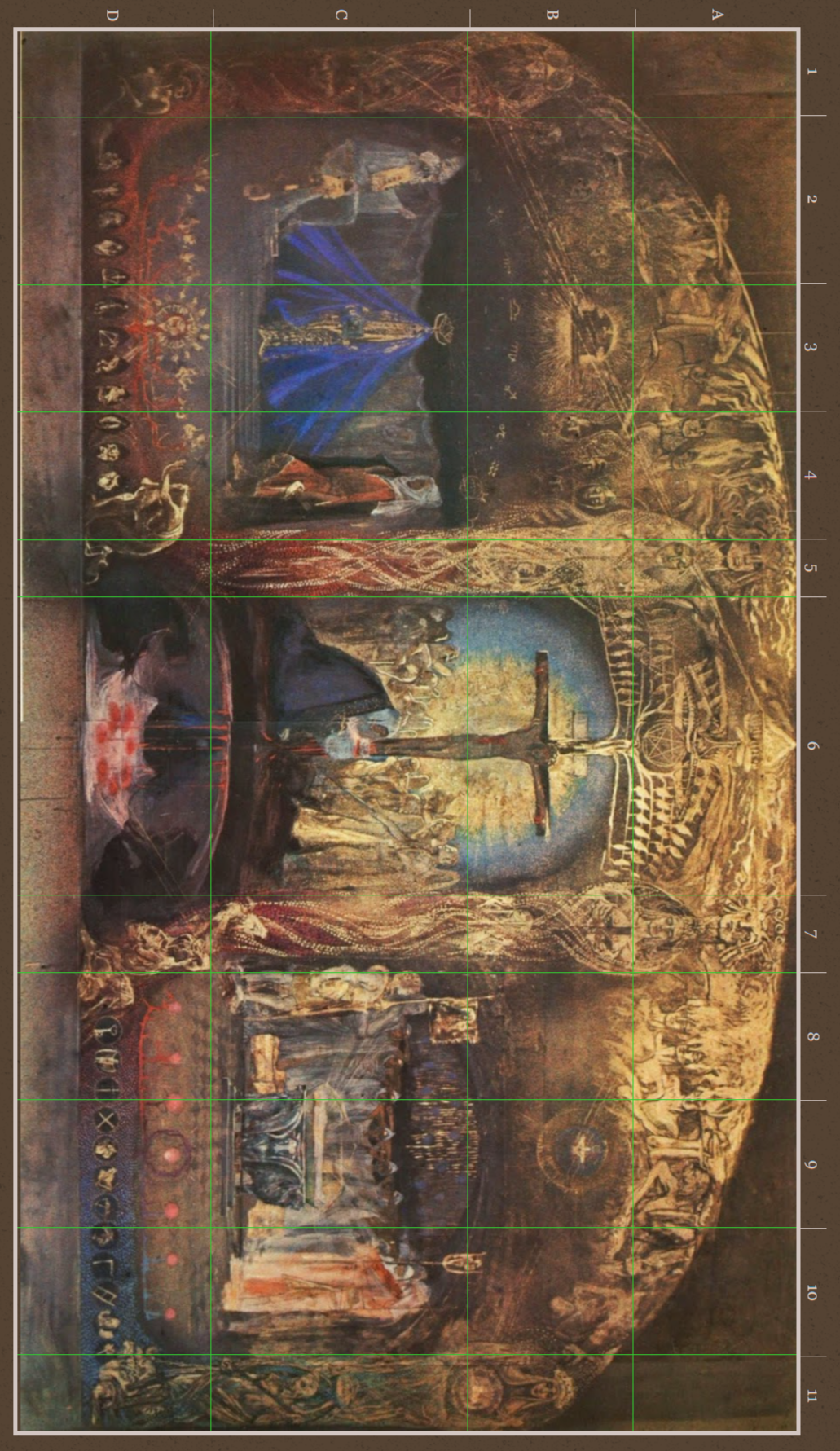- Origin and Overview of the Painting
-
Preface
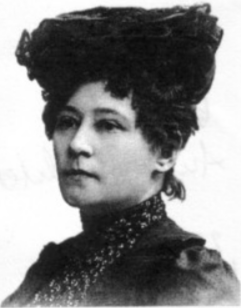
Anna May This painting had for a long time been veiled in mystery. It was spoken of in Anthroposophical circles for many years after the death of Rudolf Steiner, yet no one knew where it was and, hence, it was rumored to have never really existed. However, it wasn't until the 1970's that (I believe) a niece of Anna May Richter, Margarethe Hauschka, found a glass plate copy of the painting in the attic of her mother's estate. She was compelled to share it with the world and bring to light its history.
Below I have included excerpts from an article/letter written by Margarethe Hauschka about the painting. I have also included various insights and views expressed by Douglas Gabriel in his article Mysterious Painting Reveals Initiation of Christian Rosenkreutz. (Note of opinion: I am not as much in agreement with Gabriel's assessment of the Triptych painting as I am of Adrian Anderson's interpretation, of which is the primary source of information in this page.)
-anthony
All of Freemasonry is based upon the "two John's of Jerusalem," who are known as St. John the Divine and St. John the Baptist. Prior to building the First Goetheanum, Steiner had planned to build a hall in Munich which was to be dedicated to Lazarus/St. John with the name Johannesbau, or St. John's building. We know from Steiner that Lazarus/St. John was also the mysterious figure Christian Rosenkreutz, the founder of Rosicrucianism. The spiritual history, life, and teachings of Rosenkreutz was first promulgated in three initial books by Johann Valentin Andreae and later through Henricus Madathanus and others. Prior to these books, the life of Christian Rosenkreutz was one of great mystery and spiritual import.
Although Rosenkreutz's incarnation in the thirteenth century was not recorded in outer history, Rudolf Steiner was able to determine through his clairvoyance that this was his incarnation of a "wondrous child" who was initiated by the twelve great masters. The right panel of the painting, known as a triptych, displays the initiation of Christian Rosenkreutz as a model for all humans to follow in the distant future.
The Johannesbau was to have the triptych in a central position of the building, demonstrating Rudolf Steiner's personal knowledge and experience with the founder of Rosicrucianism. Steiner's Anthroposophy is a form of Rosicrucianism inspired by Christian Rosenkreutz, who we know later by the name of the Comte de Saint Germain who lived in the eighteenth century.
-Douglas Gabriel
From Solomon through Golgotha to Christian Rosenkreutz
The Grail Triptych
by Margarethe Hauschka
In the estate of my mother I found an old color transparency from the beginning of the 20th century. It is the triptych "Grail" that great picture of the painter Anna May, which she painted at the time of the Munich mystery dramas (1909-13). This image was originally planned for the "Johannesbau" in Munich, later intended for the first Goetheanum. It was, however, by other fateful dispensations years after the [First World] war, given to the Hamburg Waldorf School and during the Second World War was destroyed by the bombing.
Since I knew it was about the only colored reproduction, which still existed, I felt the obligation to snatch this work, to which Rudolf Steiner had personally given important instructions, from oblivion and make it once again accessible to all. It was a wall-filling image, estimated 2.5m high, and 4m long. Hanging for a time on exhibit in the Glass Palace in Munich, Anna May herself provided a description at the request of the exhibitors, from which I provide an excerpt [below]. It was entitiled: "From Solomon through Golgotha to Christian Rosenkreutz" Triptych.
"The pivotal point in human history is the mystery of Golgotha, 'Holy Grail' is the word for man inasmuch as he seeks relationship to this event. The legend says that the Grail is a hollowed out stone, that Lucifer lost from his crown when he fell. Solomon receives it from the Queen of Sheba (left part of the triptych).
"Then it becomes the Last Supper cup, in which Joseph of Arimathea had caught the holy blood (middle part of the triptych).
"When this Christ blood has penetrated to the innermost depths of the Earth in the distant future, so also will the thoroughly Christ-filled human being, the Parsival of the future, awake from out of the grail chalice as from a coffin and unify all religions and earlier philosophies into a living Christ wisdom. Then Michael will also have bound the dragon, and the 'woman' of Revelation will again take in the Sun with the Moon underfoot, then the Earth will have achieved victory over being chained to matter.
"The upper part of the triptych Grail portrays the spiritual world (gold), the uppermost heads are the Time Spirits (Archai), who extend their hands over long periods of time; supporting them are the folk-spirits (Archangels).
"Under these looking down on the people are the Angeloi or angels. In the lower part, i.e., the two pillars, is represented the blood streams which flow through humanity and connect with the spiritual (gold), enabling higher guiding beings to incarnate, who lead the evolution of mankind."
[...]
The triptych Grail was demonstrably on display in 1918 Munich in the art house Reich and later the Kunsthaus, and somewhat later still in the Glass Palace. From this period comes the above description written by Anna May as required for exhibitors.
...
One can also say from this picture that the meaning of Earth evolution lights up as the eye sweeps from left through the middle and again to the right. It appears in the middle as the Blood flows deep into the Earth, and the post-Christian mysteries, starting with the Last Supper, are mysteries of the Blood. So also the Grail mysteries. Joseph of Arimathea captures the Blood, as it were for humanity. What is captured by the Norns (deities in Norse mythology responsible for shaping the course of human destinies), absolves the Earth, and draws the power of Christ into destiny, whose Lord Christ becomes.
In such a manner one can stand before the picture and slowly learn to read it. It's not symbolic, it is a painting of spiritual history, of course, in the guise appropriate to the style at the beginning of the 20th century.
...
In this painting, which was very large and was apparently originally intended to have a place in the First Goetheanum, expresses in images what Steiner otherwise expressed in his writings and lectures. The theme is the Holy Grail. In his book Esoteric Science, an Outline which provides the most comprehensive overview of Anthroposophy published in 1910, he refers to Anthroposophy as a Grail Science.
Overview Provided by Margareth Hauschka
Part 1:
This comprehensive imagination reflects Steiner's reading of the Akashic Record (Cosmic Memory). The Mystery of Golgotha is being depicted as the central event of world evolution. Two streams of time converge in this center, the one that comes from the pillar on the far left (Jachin) which includes Melchisedek, Abraham, Isaac and Jacob flows along the bottom is connected with the red blood and is met by the bowing figure of Moses beholding the descending Christ in the burning bush, from which he hears the voice of the Logos proclaiming "I Am the I Am". This etheric stream that flow out of the past and worked through the hereditary lineage of Abraham prepared the body temple over 42 generations that would become the Grail Vessel into which the Christ would later descend. The focal point of Hebrew faith was the Temple that began as a tent in the wilderness but was later built in Jerusalem through the collaboration of king Solomon (Abel stream) and Hiram Abiff the master builder (Cain stream). Between these two individualities is the Queen of Sheba over-lighted by the Sophian star wisdom which was still alive at that time.
Opposite Moses is Paul who through his Damascus experience prefigures the experience of the Second Coming of Christ that is unfolding in our time. The initiation of Christian Rosenkreutz who is the reborn Hiram is the central theme of the panel on the right. The far fight pillar (Boaz) represents the astral stream of time that flows prophetically and apocalyptically out of the future, as is associated with the blue blood. Hence the figures of the Archangel Michael and Sophia who appear as the main characters in the central drama that unfolds at the very heart of the Book of Revelation. The Rosicrucian Initiation expressed by the seven red roses are a means of aligning one self to these New Mysteries that prepare the future by helping to build the New Jerusalem which involves the transformation of the Earth into the Golden City known esoterically as the Planet of Love.
Part 2:
The impulse toward this entered human and earthly evolution through the intervention of the Cosmic Christ being through His descent into the physical body of the man Jesus of Nazareth in his thirtieth year and after totally transmuting the three Astral, Etheric and Physical sheaths that underwent the sacrificial event of the Mystery of Golgotha. This involved alchemically transmuting the Phantom Body which underlies the physical body which had been corrupted through the Luciferic intervention which inevitably led to the invitation of Ahriman the Lord of Death into the human organism. The Christ revered as the Sacrificial Lamb without spot (karma) who's infinite LOVE was poured out with the Sacrificial Blood which in its inner fire or warmth is the medium of the human Ego raising it into a communion with the divine "I AM". This precious gift that reversed the consequences of the Fall is caught up in teh Grail Vessel made Holy by this overflowing Love by Joseph of Arimathea.
That Sacred Blood which flowed down to the Earth was etherized and drawn into the etheric aura of the Earth, this sun aura of the Earth is also the memory body of the earth that reaches back to the three former stages Old Saturn, Old Sun and Old Moon expressed symbolically by the three Mothers (see: https://anthroposophy.eu/Three_mothers) who harken back to these periods and together embody the threefold soul of the Earth. By receiving this Sacred Blood which bore within it the power of the Divine Logos, the Seven Solar Elohim, these three Mothers received the Christ's Resurrection Impulse which instilled into the Earth the power of the resurrection as a means of over-coming the inevitable death of our common body the Earth so that it can in the future become the radiant Body of the Christ Earth-Sun. The blood arrayed as a circle of seven roses expresses the restoration of the divine plan that stretches from Old Saturn (1st Stage) al the way to future Vulcan (7th Stage). The Cross becomes the renewed Tree of Life which Christ as the new Planetary Spirit restored. Around it are gathered souls who have the Buddha Gautama, who helped to prepare this central event is shown in the pillar to the left of the central panel, the Beloved Disciple John who later reappears as Christian Rosenkreutz is shown in the right pillar, both are aligned to teh inspirations of pre and post Christian Archai (time spirits) who reach out to one another and penetrate them from above.
Part 3:
The divine trinity symbolized by the Golden Triangle at the top center is the source of the Divine Plan that rays out into both past and future streams of time. One such stream rays out through the forehead of Buddha, then the ark of the Covenant that hovers over the left panel and streams onward towards the pre-Christian Grail-Cup that the sun-initiate Melchisedek bore when he bestowed his blessing upon Abraham the hereditary father of the Hebrew people who will henceforward come under the Lunar Divinity Jahve, we know esoterically as the seventh Elohim (Spirit of Form). Another golden stream emanates on the opposite side towards the future with the same angle touching the forehead of the beloved disciple passing through the image of the crucified one that hovers above Christian Rosenkreutz who has invoked the In Christo Morimur and continues onward to the Heart of the Virgin Sophia who gives birth to the Second Coming of Christ. From the heart of the Virgin and the Grail Chalice held by Melchisedek, the golden rays proceed inward. On the left they pass through the head of Solomon who was granted the gift of Wisdom on through the pre-Christian Grail vessel that the Queen of Sheba bears, then endowing the Golden Sun Hammer (Tau-Tao) held by Hiram with its magical power touching the bowed head of Moses and culminating in the sub-earthly chamber where the Mothers gather in the Communion that gives the Earth its Meaning. From the other side the corresponding rays pass through the Chrystal that envelops the semi-transparent body of the youth laid upon an Altar formed of the four living creatures then touching and opening the eyes of Paul, and finally converging with the other stream coming from the past.
Lucifer's Crown is alluded to as a ring formed by a serpent biting its tail that can be seen in the canopy of the central tree. An Alchemical vessel is there in the opening where the crown's central jewel once had its place, and had been dislodged by Michael during the battle in heaven. This Jewel, expressive of the perfect balance of the four members of the human being now endowed with the power of Christ, is seen as a fruit that has grown out of this sacrificial deed. The members of the 3rd hierarchy who act as mediators and servants helping to carry out the divine plan are arrayed above. The angels are imaged as winged heads while the archangels have flames rising upwards to the heights. Around the renewed Tree of Life are gathered the many souls who have been drawn to this new manifestation of the Christ Sun who has enacted this central event of the great seven-fold drama upon the stage of human and earthly history, making this both a profoundly spiritual as well as being deeply imprinted into the dense physical substances that were transmuted into the Resurrection that prefigured the transubstantiation of the entire physical body of the Earth.
- I. Melchizedek ( B1 & C1 )
-
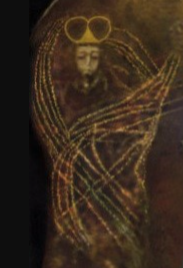
The great leader of the Atlantean Sun Oracle. He is presented in the Book of Genesis as the entity who inaugurates the tremendous mission of Abraham, which was to establish the twelve tribes of Israel [from whom the pure physical bodily sheath would be drawn to house the Christ during His three years on earth].
Rudolf Steiner describes Melchizedek as an Angelic being, not a human being. In one lecture he calls him, "the Angel of the 'earthly rotation time'"; in another he is described as being the "Light purifier [for the earthly world] prior to the Cosmic Christ taking on this task" after the events of Golgotha.
- II. Abraham & Isaac ( D1 )
-
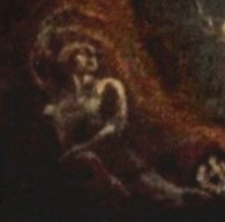
Isaac
In this corner of the painting is Abraham with his son Isaac. Unfortunately only Isaac is visible in the preserved image.
Isaac here points to an important theme: The high level of obedience and self-sacrifice which was required of those who are servants of divine will. This theme of serving divine will, of being obedient to higher powers, is referring to Abraham's crucial spiritual test. This test involved being (apparently) ordered to sacrifice his son to God. As a result of his obedience, Isaac is 'restored' to Abraham, that is, he is exempted from being a sacrifice.
Rudolf Steiner explains that this episode, so alien to us today, has to do with the stern requirement of a servant of Jehovah to manifest the greatest possible surrender of his own will.
- III. Solomon ( C2 )
-
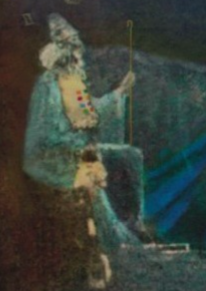
Pre-Golgotha Initiate. Among much [other] symbolism held in this image, he is illustrative of one path to seeking to attain higher consciousness: Passively receiving Cosmic Inspiration through the chaste, withdrawn meditative path.
He received the Inspiration for the building and development of the Temple, the human being, who receives into his Soul, the Spirit. He sits upon his throne at the top of the stairs that lead to the Holy of Holies.
- IV. Queen of Sheba ( C3 )
-

The Queen sets herself between Solomon and Hiram, deciding between the pure, non-earthly Cosmic Wisdom and the Wisdom achieved by conquering the lower earthly self, through intensive earthly activity.
She holds in her hands the green gemstone of the Holy Grail. Above her head is the lotus flower, the presence of the divine eternal-self which becomes present in the astral body as it flowers i.e. as the chakras form. This eternal-self, as it manifests gradually in human evolution, shall transform the physical body into the clear, radiant "soft diamond" body in the far future.
Behind the Queen is a curtain, representing the veil or curtain which covered the Holy of Holies in Solomon's Temple. The Queen of Sheba represents our soul as it begins the task of developing itself spiritually.
- V. Hiram Abiff ( C4 )
-
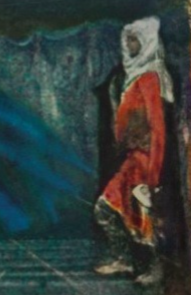
He represents the other path seeking to attain higher consciousness: By engaging powerfully in earthly activity and through trial and error, and the exercise of initiative, learning to refine and to more insightfully direct one's will.
Hiram was the master craftsman ('Abiff'), the mason sought by Solomon to build the Temple. The building of Solomon's Temple serves as an allegory to Spiritual Development. Hiram is progressing up the stairs to the Holy of Holies, representing movement of the will.
- VI. Moses ( D4 )
-

Moses bows before the burning bush, the flaming branches of which have been metamorphosed into a menorah, the branches of the bush have become seven burning candles.
Moses said to God, "Suppose I go to the Israelites and say to them, 'The God of your fathers has sent me to you,' and they ask me, 'What is his name?' Then what shall I tell them?"
God said to Moses, "I AM WHO I AM. This is what you are to say to the Israelites: 'I AM has sent me to you.'"
There has always been much confusion over the translating of this statement from the Hebrew. The first part of the verb can be translated either as I was of, I am, or I will be. Rudolf Steiner does not translate the phrase where God names himself as: "I am, am, will be that I was, am will be". He does not involve that eternal quality of "was, am and will be", instead, he lets that stay in the background and takes up the simplified version, of "I am that I am", but he changes it in a remarkable way. He translates it as saying: "I am the I am". He tells his audiences that the phrase is saying that God is the (innermost core) of the human being's sense of self, the "I".
The seven illumined branches represent the seven planets whose rays form the basis of the astral body, branching out from the center circle with the words of God spoken to Moses. Below this are the twelve zodiac forces that form the basis of our ego-sense.
- VII. Ark of the Covenant ( B3 )
-
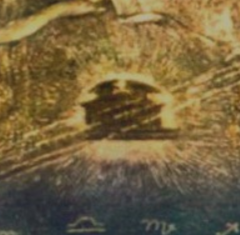
Moses was commanded by God (understood in Anthroposophy to be Jahweh-Christ) to create a wooden box (the Ark) and to place in it the stone tablets of the Ten Commandments. Jewish traditions (and as revealed in the Epistle to the Hebrews) understood that the Ark also contained a golden jar of manna and the staff of Aaron. So the Ark came to represent the divine will of God to the Hebrews. In esoteric terms it functioned as a kind of portal which gave divine beings access to the Hebrew people, through its proximity to the priests in the Temple (think of Zachariah being informed of Elizabeth being with the child John [the Baptist]).
In the painting, therefore, it is shown permeated by divine energies streaming forth from the highest feature of the entire painting – the radiant triangle in the center of the picture, symbolizing the Divine, or God.
Also shown here are two Cherubim, thought of as Guardian Spirits. However there is no mention of these Guardians until 300 years after Moses. King Solomon had these two spiritual beings carved and placed on the Ark when he had it moved from a temporary location into the Holy of Holies inside his new (and actual) Temple. Here is emphasized the task of building the spiritual temple, the vessel for our future Spiritual-self.
- VIII. The Two Columns ( A5,7; B5,7; C5,7 )
-

Left Column 
Right Column Overview
Solomon's Temple had two columns on either side of the entrance. In the description of Solomon's Temple, these two columns are given the names Jachin (left) and Boaz (right). Jachin represents Solomon (wisdom), the meditative path that leads to receiving wisdom into the soul: When you can go beyond an idea (which is a mental image) for a project, and attain the state of sensing the vibrant astral image or living thought form behind the earthly thought, then you can undertake your work out of a living, creative wisdom. Boaz represents Hiram (activity/strength), the path of being actively involved in transforming the material world and achieving skill and insights: When you put your will into the material world — for higher purposes — then you are being creative as part of the cosmic reality.
Note: In the painting, the two columns are set on either side of the Christ deed (the Mystery of Golgotha), which is the entrance into an understanding of the cosmic realities of life. ~anthony
At the top of these two columns are Principalities who become the Regents of the cultural epochs such as the post-Atlantean Ages (i.e. Time Spirits), each of which lasts 2160 years.
Looking at the whole upper section of the painting, we can see the arms of each of the Time Spirits extending out, and their hands are grasped by a hand from another Principality at the very top of the left and right of the painting, where it begins to curve downwards. Underneath where these hands meet, are two Archangels whose arms are bent directly upwards, supporting the meeting of the hands of two Time Spirits. This indicates interaction of the Archangels with the Principalities.
The hands of the two Regents meet above the Cross, suggesting the Age prior to the Mystery of Golgotha ended and the Age post the Mystery of Golgotha, right at AD 33. This, of course, is symbolic as the transition from one age to the next occurred in 747 BC (see below).
The Column on the Left
The Time Spirit prior to the Mystery of Golgotha was that of the Folk-spirit of ancient Egypt (understood by the head-dress), Pharao, who, during the Age of Taurus (the Third Post-Atlantean Age) became the Regent of that Age, which we call the Meso-Egyptian cultural epoch (lasting from 2907 to 747 BC).
Depicted below Pharao is the Buddha, representing the last of the great initiates of the pre-Christian era.
Below Buddha is a face with closed eyes, representing the pre-Christian acolytes who were initiated in a manner that did not use the conscious ego-sense; instead the acolyte was put into a kind of sleep state for three days (very much like a near death experience whereby the acolyte was revealed cosmic mysteries ~anthony).
The Column on the Right
The Time Spirit after to the Mystery of Golgotha was that of the Folk-spirit of ancient Greece (understood by the head-dress), Hellas, who, during the Age of Aries (the Fourth Post-Atlantean Age) became the Regent of that Age, which we call the Greco-Latin cultural epoch (lasting from 747 BC to AD 1413).
Depicted below Hellas is Lazarus-John, holds the Earth, on which is a cross. He represents the first of the initiates appearing after the Golgotha events. Rudolf Steiner revealed in more private circles that Hiram incarnated again at the time of Christ, and became this elect person, who was initiated by Christ in the 'raising of Lazarus'.
The globe wih a cross within it represents the Earth as belonging to Christ, emphasizing that the great sun god has become the Spirit of the Earth. Plato made the esoteric statement that the Divine as embodied within the world, with its fourfold structure (i.e. the four primary elements: Fire, Water, Earth, Air) and associated etheric forces (the cross divides the globe into four sections). Rudolf Steiner explained this in a lecture in 1902:
In the cross we have the same concept as we have in the philosophy of Plato, in which the All-Spirit (Soul of the World) is crucified (in the fourfold material world).
Incidentally, the short inscription written by Pontius Pilate and placed on the cross and in the Rosicrucian inspired Isenheim Altarpiece portrayed by just the four letters JNRJ is explained by Rudolf Steiner that these four letters represent the four elements, being the first four letters in Hebrew of water, fire, air and earth. In this painting the small inscription is there but the words or letters are not shown.
Below Lazarus-John is a face with open eyes, representing how initiates arise in the post-Golgotha era. They are aware of what is developing in their consciousness; their ego-sense is retained in the process of developing the higher ego.
- IX. The Crucifixion Scene ( B6 )
-

The core aspect of Esoteric Christianity as taught by Rudolf Steiner is that the Cosmic Christ being descended from spiritual realms 'behind' the physical sun and united to the Earth's aura. What we know (or don't know/understand) as Christianity is in fact something other than a new religion, which transcends the formal structure of a religion. The scriptures of this religion present a sacred narrative, but they also veil a profound cosmic event, the full understanding of which requires initiation wisdom. So what is the core difference between Esoteric Christianity and that of the churches today? It is the difference between 'Jesus' and 'Christ'.
Rudolf Steiner taught that there is a cosmic deity overshadowing Jesus (a human being, though an immensely holy person). In Anthroposophy, the term 'Christ', when strictly used, refers to the cosmic being who came upon (or 'anointed') Jesus at the Baptism in the Jordan River. So in Anthroposophy, the person known as 'Jesus Christ' is a being consisting of the man Jesus and also of the deity, the Christ being, who became present in him as from the Baptism. This viewpoint of two distinct but deeply interlinked entities being involved was held by earlier Christians, including the great Origen of Alexandria, but later this view was condemned as heresy.
In Anthroposophy, the deed of the Cosmic Christ occurring on Golgotha hill at Jerusalem is understood to have resulted in a permeation of the aura of the Earth with sacred spiritual energies. As Jesus died on the Cross, the great deity illumining him, the Cosmic Christ, merged its own divine etheric and astral auras with the aura of our planet, with mother Earth. This is the most sacred and important event in the lifespan of the planet.
The depiction of the Golgotha event here has an awe-inspiring, evocative quality due to many features, but in particular this quality is created by the lower section, which depicts the blood of the Redeemer flowing inside the Earth. Another striking feature, adding to the power of this scene, is that the group of witnesses gathered behind the cross are, with one exception, all spiritual beings, not human beings. Consequently the event, while treated as a physical reality, is also being depicted from the viewpoint of a spiritual entity, or a clairvoyant person. As a result, instead of an area of darkness enveloping the cross, as in Matthias Grunewald's masterpiece, the Isenheim Altarpiece (another Rosicrucian-initiate inspired painting), here we see a golden-yellow auric glow around the body of Jesus. This indicates the presence of the cosmic sun-god Christ, whose sublime spiritual nature is about to permeate the Earth's aura.
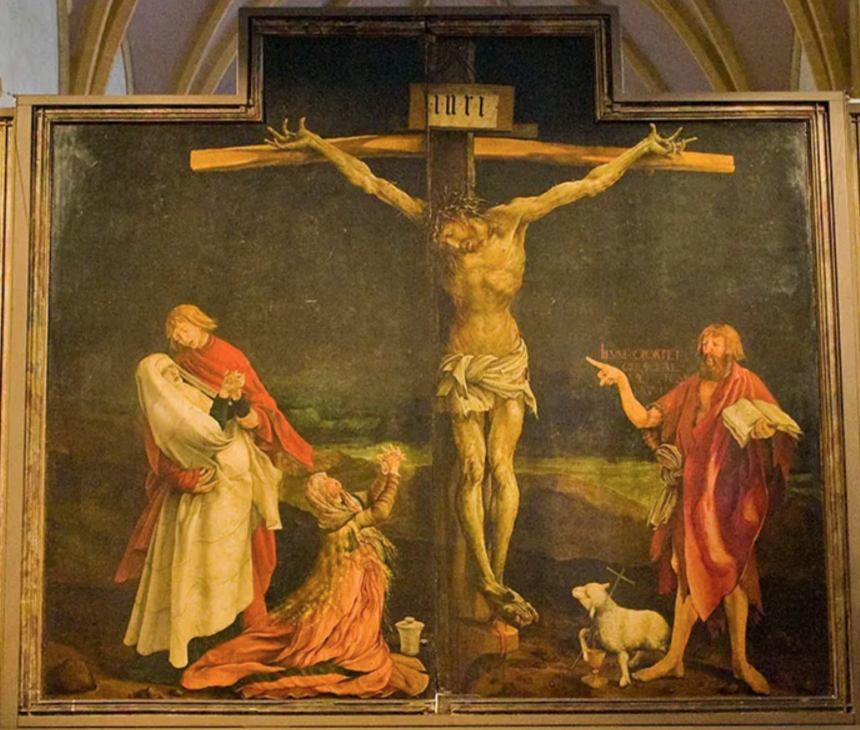
Isenheim Altarpiece, the Crucifixion scene - X. A Crowd of Witnesses ( C6 )
-
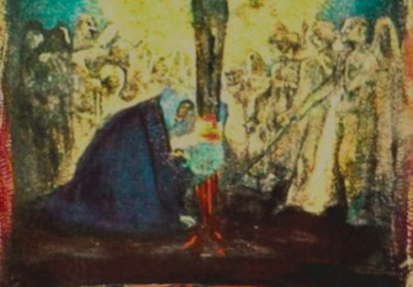
Gathered around and behind the Cross is a crowd of about 20 entities, the only one of which that can be identified is the Archangel Michael, who is seen on the right side of the scene, holding his sword pointed downwards toward the Earth's interior. This affirms the knowledge incorporated in an early Christian apocryphal text, The Questions of Bartholomew, portraying a dialogue between the risen Christ and the disciple Bartholomew:
And Bartholomew said: "Lord, when Thou went to be hung upon the cross, I followed The afar off, and saw Thee hung on the cross, and I saw the Angels coming down from Heaven and worshipping Thee. And then there came darkness; I beheld, and I saw that thou wast vanished away under the cross, and I heard only a voice in the Earth's interior... Tell me, Lord, whither wentest thou from the cross?"
And Jesus answered and said: "Blessed art thou Bartholomew my beloved one, because thou sawest this Mystery... when I vanished away from the cross, then I went down into Hades that I might bring up Adam and all that were with him, according to the plea of the Archangel Michael." Then, the ascent of Adam up out of Hades is seen, he was borne aloft by Angels... Again Bartholomew said: "Lord, I saw the Angels ascending before Adam and singing praises. But one of the Angels, which was [a] vary great [being], superior to the rest of the Angels, would not ascend up with them; and there was in his hand, a sword of fire, and he was gazing steadfastly at Thee only. And all the Angels besought him to arise with him, but he would not."
Published in The Apocryphal New Testament, p. 166–186, Oxford UP, 1975
The Archangel Michael is an especially significant member of the hosts of divine beings around the Cosmic Christ. He was known as the 'countenance of Jahve' in Old Testament times.
Joseph of Arimathea
Kneeling at the foot of the Cross is Joseph of Arimathea, holding a cup in which to receive some of the holy blood. Here he is the only physical witness to the crucifixion scene depicted in the painting, though we know other people were present. Joseph of Arimathea was a member of the Jewish ruling council, the Sanhedrin, and a wealthy follower of Jesus who requested the body of Jesus from Pontius Pilate, in order to provide a proper burial. Though this scene is not described in the Gospels, it is a major portion of Grail lore and is part of esoteric wisdom.
The cup in Joseph's hands (the Holy Grail) is obscured by the radiance emanating from it. Medieval Holy Grail legends present several different descriptions of the cup; it could be an actual cup or an emerald stone, thought to be that of which fell from the crown of Lucifer when he was cast down from Heaven. The Grail Mysteries were part of the Rosicrucian movement, and therefore of its modern form, Anthroposophy.
Though the garments worn by Joseph appear feminine, Anna May was explicit in her stating this figure as Joseph of Arimethea. There are symbolic reasons for his clothing which are long and deep, which we won't delve into here. Suffice it to say, every aspect of this painting holds esoteric meaning and symbolism; in other words, every aspect has purpose, a truth to convey.
- XI. The Subterranean World ( D6 )
-
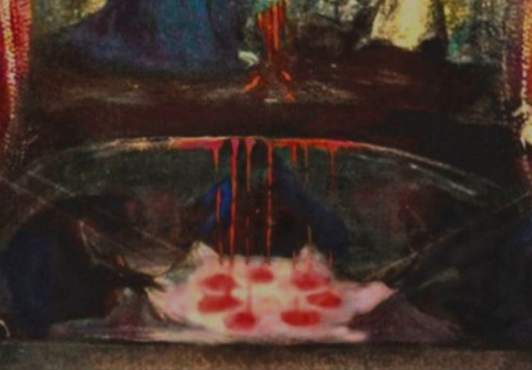
What is depicted here is the blood of Golgotha penetrating the Earth and taken up by 3 figures. This is symbolic of the spiritual forces of the Cosmic Christ. The blood is the vessel of the astral energies. Within the astral body of (or soul) of Jesus, the divine Cosmic Christ was present. Within our soul, hence in our bloodstream, these same forces are to become present (though to a much lesser degree).
The scene as a whole is best understood when viewed from the wisdom of various esoteric traditions. From the ancient Druidic mystery wisdom, preserved in the Icelandic text known as the Edda, There is a Masonic legend of how from the Cross of Jesus, an acacia tree blossomed. If we view the entire Crucifixion scene as a whole, we have the figure of a tree, a kind of Cosmic Tree of Life i.e. the 'World Tree' known as Yggdrasil in the Edda. Jesus hangs in the middle of this tree, whose roots are below the surface of the ground where the three dark entities are and the foliage extends above Jesus. The image of a great tree is also noted in other mystery traditions, such as Egyptian Freemasonry and the Rig Veda. In the Edda, underneath the tree are the three Norns – three figures that represent the past, present and future; these three figures spin the thread of world karma.
In this painting, these three beings depict the threefold soul forces of thinking, feeling and willing, which absorb the divine spiritual energies or astral and Devachanic light which permeated the Earth at the death of Jesus. This process however, of gradually becoming a spiritual human being through the presence of the Christ-light in the soul and spirit, occurs more in the hidden recesses of the soul. It is not such a process monitored by the "I" or ego, i.e. by our normal consciousness. It occurs down in the depths of the human being. From this viewpoint these three beings represent our three soul qualities. Though much more involved to gain elucidation than we deal with here, it is important to note that the Christ-light also permeates the remote depths of the planet's interior, down to its core, the realm of the Spirit of the Earth. When the intellect strives to picture such truths, it is important to remember this quote of Rudolf Steiner:
What man sees in the kingdoms of Nature around him on the physical plane, he takes to be reality. He looks at an animal or a plant, and pictures to himself that these are realities in the forms in which they appear. But in truth it is not so, for what is actually present as a reality is the spiritual world — that and that alone. And not until we have recognised the Spiritual in the things around us do we truly know reality.
Everything else that is revealed to us in surrounding nature is tantamount only to a symbol for the spiritual world behind it. Everything to be seen in the kingdoms of mineral, plant, animal, and also in the physical human kingdom, everything that makes an impression upon the sense-organs, upon intellect and intelligence — all these things are nothing but symbols of the Spirit; and only one who learns how to interpret these symbols reaches the reality, the Spirit.
Source: Rudolf Steiner – GA 143 – Calendar of the Soul – Cologne, May 7th, 1912
https://rsarchive.org/Lectures/CalSou_index.htmlSo, when considering the physical world in which we live as "maya", or "illusion" let us remember that we are not meaning to say that the physical world is of little or no importance. What we see and experience around us is a product of much spiritual effort and sacrifice and should be regarded as such with gratefulness and awe. ~anthony
The Christ-force, represented by the blood, being gathered up by the three beings, is forming into seven oval shapes. This image is alludes to the rose-cross with its seven roses, although the symbol didn't become formed until the Rosicrucian brotherhood was established in medieval times. The entire painting is a holy revelation about Esoteric Christianity, and a major part of this revelation focuses on the leader of the Rosicrucian Movement. For this reason, the impact on humanity of the Christ-light, which now exists within our planet, is viewed from the perspective of the actions of the high initiate, Christian Rosencreutz.
Hiram, the master builder of Solomon's Temple reincarnated as Lazarus, who was initiated by Christ Himself and became Lazarus-John, the "disciple who the Lord loved"* and wrote the Gospel of John. Lazarus-John was given a lofty task in serving the Savior, indicated in a striking passage at the end of the Gospel of St. John:
Peter turned as saw that the disciple whom Jesus loved was following them. (This was the one who had leaned back against Jesus at the supper and had said, "Lord, who is going to betray you?")
When Peter saw him, he asked, "Lord, what about him?"
Jesus answered, "If I will that he remains until I am appearing, what is that to you? You, follow me."
The expression until I am appearing refers to what Rudolf Steiner explains as the re-appearing to humanity's consciousness of Christ (subtly in the ethers), an event which was destined to take place as of the 20th century; this is the so-called Second Coming of Christ. This remarkable reply hints at the extraordinary and blessed destiny about to unfold for Lazarus-John, as an initiate very close to Christ Jesus. He shall be gaining the eternal or 'deathless' consciousness of an adept (and the associated occult powers). His destiny will be focused on the continual task of inspiring and strengthening Christian awareness in Christendom, to help prepare people to be receptive to the influences from Christ when He re-appears. In the course of this mission, Lazarus-John will eventually become the founder of the Rosicrucian Movement. In the subterranean scene of the painting, the seven blood-red oval shapes are pointing ahead to the sacred mission of Christian Rosencreutz, he who appears in the right side column underneath 'Hellas'. That is, this great initiate will be establishing the Rosicrucian Movement, which will have the rose-cross as its primary sacred symbol.
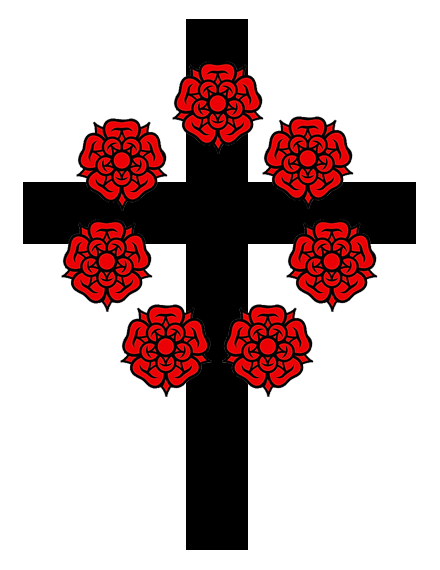
The Rose Cross symbol Rudolf Steiner had this to say about the "rose cross" symbol:
Consider how at the Mystery of Golgotha a cross was erected of dead wood from which hung the body of the Christ.
And then we see that wood of the cross in the etheric world as budding, budding wood, green, living wood, charred by the flames of hatred and on which alone appear the seven blooming roses, representing the sevenfold nature of the Christ
... then there we have the image of the second Mystery of Golgotha, which has now taken place in the etheric world. (1913-02-08 GA265)
...
The wooden cross represents the dying part of the lower Self and bodily principles from which are born and emerge the pure spiritual principles represented by the red roses.
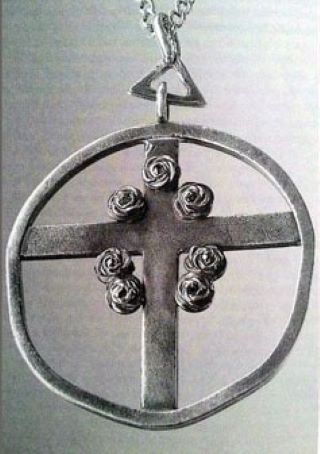
The Rosicrucian necklace worn by Rudolf Steiner Rudolf Steiner reveals that Lazarus-John has been incarnate in every century since the time of Christ, although 'an incarnation' in this case need not always mean being physically born, but rather overshadowing a person.
* The word for 'love' here is from the Greek word 'agape', referring to a profound reality. It means to have 'good-will' in the profound sense of being inwardly in union with the core of another person. It refers to a love arising in the core of the soul, in its will-forces, rather than only in the emotions. It is a condition that requires a truly selfless, spiritual love, because the higher will of the human being is then active, and the higher forces of humanity have a divine origin.
- XII. The Tree of Life ( A6 )
-
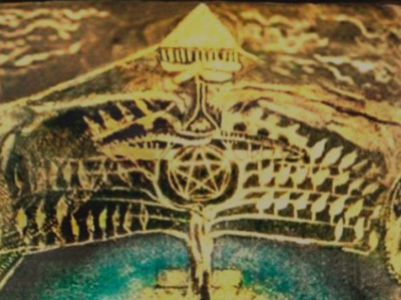
Legend of the Cross
In this portion of the painting we see that out of the wood of the Cross has 'grown' a tree, in the branches of which are various esoteric symbols. A tree springing from the Cross of Golgotha formed part of the Rosicrucian teachings. In these teachings, a cutting from the original Tree of Life, planted on Adam's grave, is linked to the Temple of Solomon, and via the Queen of Sheba, to the Cross of Golgotha. Rudolf Steiner described this legend in a lecture given on May 29, 1905:
Since we have spoken several times about Christianity and its present and future development, we have reached the point where today we have also to consider the meaning of the Cross symbol—not so much historically as factually.
You know, of course, what an all-embracing and symbolical meaning the emblem of the Cross has had for Christianity; and today I would like just to shed light on the connection between the Cross symbol and the significance of Solomon's Temple for world history.
Indeed there exists a so-called holy legend about the whole development of the Cross; in it we are dealing less with the Cross sign or its universal symbolical meaning, than with that very special and particular Cross of which Christ speaks, the very Cross on which Christ Jesus was crucified. Now you know too that the Cross is a symbol for all men, and it is found not only in Christianity, but in the religious beliefs and symbolism of all peoples, so that it must have the same common significance for all mankind. However, what particularly interests us today is how the Cross symbol acquired its basic significance for Christianity.
The Christian legend about the Cross is as follows: we shall begin with it.
The wood or tree from which the Cross had been taken is not ordinary wood, but—so the legend relates—was, in the beginning, a scion of the Tree of Life, which had been cut for Adam, the first man. This scion was planted in the earth by Adam's son, Seth, and the young tree developed three trunks which grew together. The famous rod of Moses was later cut from this wood. Then, in the legend, the same wood plays a role in connection with King Solomon's Temple in Jerusalem. That is, it was to have been used as a main pillar, in building the Temple. But then something peculiar came to light. It appeared that it would not fit in any way. It would not let itself be inserted in the Temple, and so it was laid across a brook, as a bridge. Here it was little valued until the Queen of Sheba came; as she was crossing it, she saw what the point about this piece of wood was. Here indeed she had for the first time met again with the meaning of the wood [used for this] bridge, which lay there between the two spheres, between the bank on this side and the bank on the other side, for crossing over the stream. So then, the Cross on which the Redeemer hung was made out of this [same] wood, after which it set out upon its various further travels.
Thus you see that the point of this legend is to do with the origin and evolution of the human race. Adam's son Seth is supposed to have taken this scion from the Tree of Life, and it then grew three trunks. These three trunks symbolise the three principles, the three underlying forces of nature, Atma, Buddhi and Manas, which have grown together and form the trinity which is the foundation of all growth and all development. It is apt that Seth—the son of Adam who took the place of Abel, murdered by Cain should have planted the scion in the earth.
You know that on the one hand we are dealing with the Cain current [of evolution] and on the other hand with the descendants of Abel and Seth. The sons of Cain, who work upon the outer world, cultivate the sciences and arts in particular. They are the ones who bring in the stones from the outer world to build the Temple. It is through their art that the Temple is to be built. The descendants of the line of Abel/Seth are the so-called Sons of God, who cultivate the true spiritual part of man's nature. These two currents were always somewhat in antithesis. On the one hand we have the worldly activity of man, the development of those sciences which serve man's comfort and outward life in general; on the other hand we have the Sons of God, occupied with the development of man's higher attributes.
We must make ourselves clear about it: the viewpoint from which the Legend of the True Cross springs, makes a firm distinction between the mere outward building of the World Temple through science and technology, and what as religious warp and woof works towards the sanctification of the whole Temple of Humanity., Only because this Temple of Humanity is given a higher task—only because the outer building, so to speak, serving as it does only our convenience, makes itself into an expression of the House of God—can it become a receptacle for the spiritual inner part in which the higher tasks of humanity are nurtured. Only because strength is transformed into striving for heavenly virtue outward form into beauty, the words of man's ordinary intercourse into the words that serve divine wisdom, and thus only because the worldly is remodelled into the divine, can it attain its perfection. When the three virtues, Wisdom, Beauty and Strength, become the receptacle of the divine, then will the Temple of Humanity be perfected. That is how the viewpoint underlying this legend looks at the matter.
The Temple Legend, GA 93, Part II, 29 May 1905, Berlin
https://rsarchive.org/Lectures/GA093/English/RSP1985/19050529p01.htmlPentagram
The first symbol associated with the Tree is a circle inscribed with a pentagram. A pentagram contained within a round shape is sometimes referred to as a pentacle and has become very widespread in New Age mystical and occult circles; these various groups interpret this form in various ways.
In Anthroposophy, the pentagram has two meanings. Primarily it is explained as a symbol of the Holy Spirit, and this aspect is presented in lectures where Rudolf Steiner also proceeds to explain the hexagram (here circumscribed around the pentagram within the circle) as a symbol of the Logos and hence, in regard to humanity, of the Life-spirit (or Buddhi). Therefore, the pentagram, as a symbol of the Holy Spirit, is also a symbol with regard to human beings, of the Spiritual-self. Secondly, the pentagram depicts actual currents in the etheric body of the human being. However the former meaning is what is applicable in the painting. The pentagram in the tree is indicating that, as a result of the events on Golgotha, the Earth's aura is now permeated by the divine light of the Cosmic Christ, and this enables individual human beings to attain their Spiritual-self (emphasis ~anthony).
Ouroboros
Just above the pentagram and partially in its space is the symbol of a serpent with its tail in its mouth, the ouroboros as it was known in ancient Greece. This represents the next spiritual achievement for the human being after attainment of the Spiritual-self: Buddhi or Life-Spirit. When this high stage is achieved, then the meditant's consciousness reaches beyond time and enters into the Devachanic realms, where eternality of non-time conditions exist (this is what we normally refer to as 'heaven' ~anthony). This brings such high consciousness that all of one's previous incarnations are known and integrated into the sense of "I", which becomes therefore transformed into an eternal "I". Rudolf Steiner described the Ouroboros condition as meaning that, "...the I is [now] extending beyond the earthly sphere." Rudolf Steiner once described this mysterious spiritual part of us from the viewpoint of the etheric forces in this way:
Visualize the usual life-forces now conserved by a pure, restrained harmonious life-style, and then made to resonate, to respond, to the utterly outpouring, selfless compassion of the Spirit-self.
The etheric body in effect becomes divine as the Life-Spirit develops; and as this process gets underway, healing powers and artistic skills arise (~A). The condition of a divinely enhanced etheric body is especially closely linked to the Cosmic Christ, from whose own divine cosmic Life-Spirit, the Earth and human beings receive their Life-spirit, as the etheric body transforms. This is one of the esoteric truths behind the words of Christ in the gospels, "I am the bread of life." As we noted above, the Ouroboros serpent is partially intersecting the pentagram. The reason for this is, that the Life-spirit condition gradually develops once the Spirit-self has been attained; there is a transitional phase before it is fully developed. (As I understand it, the changes we achieve in our etheric body in any given incarnation are then 'taken up' by the Astral body — the seat of all passions, desires, etc. that make up our 'soul life' — which then becomes an actual 'permanent advancement' of our higher self. ~anthony)
Philosopher's Stone
Above the Ouroboros, the symbol of the Life-Spirit, is the symbol for the next stage of higher development, the Spirit-human. The symbol here is a Matrass (a rounded glass flask with a long neck formerly used for dissolving substances by the application of heat or for distilling). Contained in the matrass is a substance, described in alchemy as either a powder or a tincture. This substance was then subject to a heating process by which was conjured forth the Philosopher's Stone.
Rudolf Steiner, in his lectures, referred to the three well-known aspects of alchemy: A materialistic side, a medicinal-healing aspect, and a purely spiritual quest. In the materialistic aspect, alchemists attempted to produce gold from base metals. In the therapeutic aspect of alchemy has to do with research undertaken by medieval physicians in an attempt to access etheric forces for the good of others; that is to enhance the healing capacity of various elixirs and other medicines.
In regard to the third aspect of alchemy, the quest for higher consciousness, the complex language of alchemy was used to refer to spiritual development processes, undertaken by Rosicrucians, through various soul exercises. Rudolf Steiner told one audience, the "alchemy represented to the true Rosicrucians is nothing other than a symbol of the purification of the soul, the development of specific human virtues." The Rosicrucian alchemical spiritual quest is viewed in the context of the Christ-reality; the matrass shown here in the painting refers to this third aspect of alchemical strivings. But there is another aspect to the approach of the Rosicrucians to alchemy, and this concerns the transitional reality, where matter and the ethers meet. This reality is also the realm that the materialistic, and the medicinal-herbalist, alchemists were seeking to access for their respective purposes. As Rudolf Steiner taught:
There exists [in creation] a certain transitional reality, between the coarser matter and the finer. We can direct our attention to the boundary between the ethers and physical matter. What exists there, between physical and etheric reality is not similar to anything in our world. What is there, is neither gold, silver, lead or copper. There we have something which cannot be compared to any physical substance, but is the essence of them all. We have there a substance in which all other physical substances are contained; thus the other physical substances can be regarded as a modification of this one 'substance'.
So the matrass in the painting, which has some substance inside it undergoing a refining process, is probably placed here as a symbol of the physical body entering into a process of refinement, which releases the Spirit-human. As Rudolf Steiner told one audience, "The human being itself is that retort (a vessel or chamber in which substances are distilled or decomposed by heat)...which becomes transformed."
Just what kind of different existence human beings will be experiencing in the far future, when this process of producing the Philosopher's Stone is achieved, is not explained. He mentions briefly that an initiate who learns to develop the Philosopher's Stone, "transforms the cosmos", meaning the planetary spheres become refined through such a sacred achievement, because the human soul is an extract of these spheres. Also, when he mentions the Philosopher's Stone, he mentions a goal that lies nearer at hand, and which is an integral part of the painting: Approaching the Holy Grail.
The Triangle
The highest of these features in the painting, directly above the new Tree of Life, is a triangle, below which are twelve column-like forms and below these are four elongated oval shapes. From the triangle, rays of light spread out, touching Buddha, the Ark of the Covenant and reaching Melchizedek on the left side. On the right side the light streams out across Lazarus-John to the dove, as a symbol of the Holy Spirit, and on to the figure of the Spirit-self (the woman with the sun in the middle and the moon beneath her feet).
The triangle represents the Godhead, the triune divine source of creation, and beneath it, the twelve columns represent the zodiac, which has a definite role in the Bible, from the 12 tribes of Israel through to the 12 disciples and finally the 12-sided heavenly Jerusalem. The four shapes below the zodiac appear to represent the fourfold aspect to our world: THe fourfold human being of physical, etheric, astral and ego. But these four can also point to the four ethers from which the four states of matter arise.

A roadmap of the journey of the human being that pursues higher consciousness (~a) Note: Information regarding the other figures in the top portion of the painting i.e. the 'gold' area, representing Heaven, the Spiritual realm(s), is far too complex to share here (which is gone through in depth in the source book). For our purposes here, however, it is important to note that on either side is depicted an Archangel, the Time Spirit of that Age. We know from Rudolf Steiner that the seven planetary Archangels each have a Regency, which occur in a regular sequence; during any Regency, the Archangel exerts a subtle influence on the inner life of human beings. Each Regency lasts about 350 years; some are only 320-340 years in length, although the Sun Archangel Regency lasts about 460 years. On the left, just prior to the age of Pharao, is the Time Spirit Archangel Michael whose Regency at this time was around 3000 BC (ca. 3600-3200 BC) (he has since become the Regent once again in the Fifth Post-Atlantean age). On the right, when the Age of 'Hellas' ended (the Greco-Latin Age) is the Archangel Gabriel (AD 1510-1878). Michael's Regency began again in 1879 after he battled Satan/Ahriman and threw Satan down to Earth, where Michael is now highly involved in the development of the soul-consciousness of human beings. ~anthony
- XIII. The Initiation of Christian Rosencreutz ( C8, C9, C10 )
-
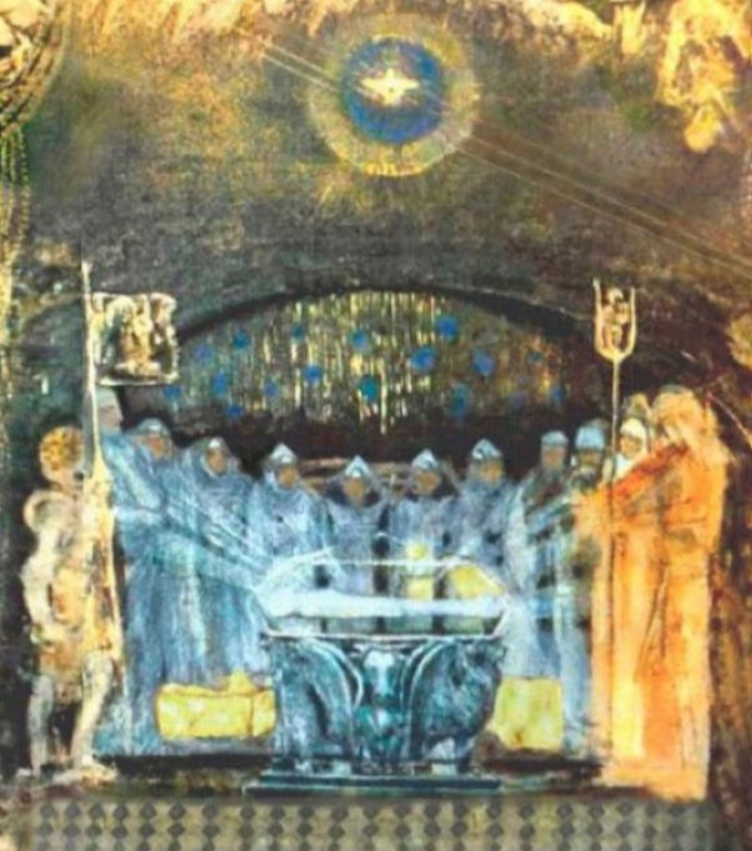
AD 1250
The central scene in the right 'panel' of the triptych is occurring below the descending dove, symbol of the Holy Spirit. This is the scene which depicts an initiation process which could be called a ceremony that occurred in the year 1250 AD. This process, this ceremony, took place in a remote location in Europe that has yet to be revealed. The focus of the ceremony is the young [holy] person lying on an unusual pedestal (a sarcophagus ~A), surrounded by a group of people. This holy person had been Lazarus-John and he is now known, as a result of this ceremony, as Christian Rosencreutz. In the painting, this scene was designed as a counterpart to the Temple scene in the first 'panel'. The two persons on either side of the pedestal, holding their respective standards, create a balancing counterpart to the effect of Solomon and Hiram.
Central to the understanding of the painting and to that of Rosicrucianism, it is best to provide Rudolf Steiner's own words about this from a lecture given in 1911. It is most likely that Anna May was in attendance at this lecture.
In a place in Europe that cannot be named yet — though this will be possible in the not very distant future — a lodge of a very spiritual nature was formed comprising a council of twelve men who had received into themselves the sum of the spiritual wisdom of olden times and of their own time. So we are concerned with twelve men who lived in that dark era, twelve outstanding individualities, who united together to help the progress of humanity. None of them could see directly into the spiritual world, but they could awaken to life in themselves memories of what they had experienced through earlier initiations. And the karma of mankind brought it about that in seven of the twelve all that still remained to mankind of the ancient Atlantean epoch was incarnated. In my Occult Science it has already been stated that in the seven holy Rishis of old, the teachers of the ancient Indian cultural epoch, all that was left of the Atlantean epoch was preserved.
These seven men who were incarnated again in the thirteenth century, and who were part of the council of twelve, were just those who could look back into the seven streams of the ancient Atlantean cultural epoch of mankind and the further course of these streams. Among these seven individualities each one of them could bring one stream to life for their time and the present time. In addition to these seven there were another four who could not look back into times long past but could look back to the occult wisdom mankind had acquired in the four post-Atlantean epochs. The first could look back to the ancient Indian period, the second to the ancient Persian cultural period, the third to the Egyptian-Chaldaean-Assyrian-Babylonian cultural period and the fourth to the Greco-Roman culture. These four joined the seven to form a council of wise men in the thirteenth century. A twelfth had the fewest memories as it were, however he was the most intellectual among them, and it was his task to foster external science in particular. These twelve individualities not only lived in the experiences of Western occultism, but these twelve different streams of wisdom worked together to make a whole.
We shall be speaking, then, of twelve outstanding individualities. The middle of the thirteenth century is the time when a new culture began. At this time a certain low point of spiritual life had been reached. Even the most highly developed could not approach the spiritual worlds. Then it was that the council of the spiritual elite assembled. These twelve men, who represented the sum of all the spiritual knowledge of their age and the twelve tendencies of thought, came together in a place in Europe that cannot as yet be named (though it never was and has yet to be ~A).
This council of the twelve only possessed clairvoyant memory and intellectual wisdom. The seven successors of the seven Rishis remembered their ancient wisdom, and the other five represented the wisdom of the five post-Atlantean cultures. Thus the twelve represented the whole of Atlantean and post-Atlantean wisdom. The twelfth was a man who attained the intellectual wisdom of his time in the highest degree. He possessed intellectually all the knowledge of his time, whilst the others, to whom direct spiritual wisdom was also denied at that time, acquired their knowledge by returning in memory to their earlier incarnations.
The beginning of a new culture was only possible, however, because a thirteenth came to join the twelve. The thirteenth did not become a scholar in the accepted sense of that time. He was an individuality who had been incarnated at the time of the Mystery of Golgotha. In the incarnations that followed he prepared himself for his mission through humility of soul and through a fervent life devoted to God. He was a great soul, a pious, deeply mystical human being, who had not just acquired these qualities but was born with them. If you imagine to yourselves a young man who is very pious and who devotes all his time to fervent prayer to God, then you can have a picture of the individuality of this thirteenth. He grew up entirely under the care and instruction of the twelve, and he received as much wisdom as each one could give him. He was educated with the greatest care, and every precaution was taken to see that no one other than the twelve exercised an influence on him.
He was kept apart from the rest of the world. He was a very delicate child in that incarnation of the thirteenth century, and therefore the education that the twelve bestowed upon him worked right into his physical body. Now the twelve, being deeply devoted to their spiritual tasks and inwardly permeated with Christianity, were conscious that the external Christianity of the Church was only a caricature of the real Christianity. They were permeated with the greatness of Christianity, although in the outside world they were taken to be its enemies. Each individuality worked his way into just one aspect of Christianity. Their endeavour was to unite the various religions into one great whole. They were convinced that the whole of spiritual life was contained in their twelve streams, and each one influenced the pupil to the best of his ability. Their aim was to achieve a synthesis of all the religions, but they knew that this was not to be achieved by means of any theory but only as the result of spiritual life. And for this a suitable education of the thirteenth was essential.
Whilst the spiritual forces of the thirteenth increased beyond measure, his physical forces drained away. It came to the point where he almost ceased to have any further connection with external life, and all interest in the physical world disappeared. He lived entirely for the sake of the spiritual development which the twelve were bringing about in him. The wisdom of the twelve was reflected in him. It reached the point where the thirteenth refused to eat and wasted away. Then an event occurred that could only happen once in history. It was the kind of event that can take place when the forces of the macrocosm co-operate for the sake of what they can bring to fruition. After a few days the body of the thirteenth became quite transparent, and for days he lay as though dead.
The twelve now gathered round him at certain intervals. At these moments all knowledge and wisdom flowed from their lips. Whilst the thirteenth lay as though dead, they let their wisdom flow towards him in short prayer-like formulae. The best way to imagine them is to picture the twelve in a circle round the thirteenth. This situation ended when the soul of the thirteenth awakened like a new soul. He had experienced a' great transformation of soul. Within it there now existed something that was like a completely new birth of the twelve streams of wisdom, so that the twelve wise men could also learn something entirely new from the youth. His body, too, came to life now in such a way that this revival of his absolutely transparent body was beyond compare. The youth could now speak of quite new experiences.
The twelve could recognise that he had experienced the event of Damascus: it was a repetition of the vision of Paul on the road to Damascus. In the course of a few weeks the thirteenth reproduced all the wisdom he had received from the twelve, but in a new form. This new form was as though given by Christ Himself. What he now revealed to them, the twelve called true Christianity, the synthesis of all the religions, and they distinguished between this true Christianity and the Christianity of the period in which they lived. The thirteenth died relatively young, and the twelve then devoted themselves to the task of recording what the thirteenth had revealed to them, in imaginations — for it could only be done in that way.
Esoteric Christianity and the Mission of Christian Rosenkreutz, GA 130, 27 September 1911, Neuchatel
https://rsarchive.org/Lectures/GA130/English/RSP1984/19110927p01.htmlHowever, in this painting, there is a thirteenth person in this group around the youth, although the thirteenth is almost totally obscured. Why this is the case here is unknown.
In that same set of lectures (GA 130) in a lecture entitled, Intimate Workings of Karma, Rudolf Steiner gave another in-depth look at the scene above: https://rsarchive.org/Lectures/GA130/English/RSP1950/19120209p01.html.
The Dove
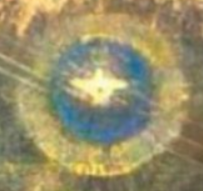
In many ways, the holiness proceeding from Christian Rosencreutz is represented by the white dove surrounded by a heavenly blue and golden halo, descending toward the sarcophagus. The dove of course is a well-known symbol of the Holy Spirit, derived from the Baptism of Jesus of Nazareth (and the incarnation of the Christ — a dove also the symbol of salvation of Noah and his Ark). In the painting the dove is the new counterpart to the Ark of the Covenant, in which God resided in the time of the Temple. The term 'Holy Spirit' is not explained as such in the Bible, however Rudolf Steiner explained it from various perspectives and this reveals that the term is multi-faceted.
It is an outpouring from the spiritual worlds, and this results in the Spirit-self forming in the human being; both the Spiritual-self together with the beginnings of the Life-Spirit in the etheric today (GA 94). It derives from the Christ-light that permeates the Earth's aura since the Resurrection (GA 112). As it forms in the human being, that person's previously rudimentary devachanic aura becomes larger, empowered and intensely radiant. But a deeply sacred aspect of the Holy Spirit is that the human being becomes part of a new 'Group-soul'. NOt one of the four apocalyptic group-souls which the sarcophagus in this scene depicts, but a new 'Group-soul community' which is part of the extended spiritual being-ness of Christ Jesus; so it is a 'Christed community' (GA 98).
Special Note: At the time of this ceremony, and alluded to in many other symbols present in this painting not addressed here, there was much celestial phenomena occurring. See pages 75–80 in Anderson's book (and partially discussed below under Joan of Arc). ~anthony
The 'Diamond Body'

This transparent 'diamond body' is also, from one perspective, the 'Philosopher's Stone'. So in this scene we are seeing that he who is shortly to become Christian Rosencreutz, has freed his body from the hardened mineral substances or 'ash' (as Rudolf Steiner referred to it), and thereby brought renewal to its spectral archetype (or 'phantom' – as Rudolf Steiner named it). Rudolf Steiner taught in regard to this,
The alchemists have always emphasized that the human body in truth consists of the same substance as that of the Philosopher's Stone. The physical body consists of an absolutely transparent reality... (GA 131)
So, humanity was sent down into the earth-bound bodily condition by the developing of an earthly consciousness or sense-based thinking, whereby the tone, that is, the Cosmic Word resonating in the ether, became only a trigger for concepts and mental images. But to a body-freed consciousness, perception of this cosmic Word results in astral thought-forms (Imaginations) being experienced. To reverse the process whereby an earth-bound consciousness arose, the spiritual seeker has to undertake a meditative training, to gain the ability to hear or perceive the cosmic Word emanating from the zodiac and the planets; and it is exactly this which the painting depicts, in this scene. The youth, in this initiatory process is doing this, as the people gathered around him speak in a mantric way. The outcome of this is that the body becomes spiritualized, or here in fact, quite transparent. (Incidentally, this is how the human body will evolve quite naturally as evolution moves forward for those who energetically seek higher consciousness across incarnations. Beginning with the event on Golgotha, humanity's evolution began an upward 'swing' (ascension) back toward its origin i.e. 'Spiritland'. ~anthony)
What we know of who the 13 individuals are in the painting surrounding the transparent acolyte is found in the pamphlet Anna May provided when the painting was displayed in the Glass Palace. In addition, with a bit more research, we can fill in some of the more unclear details (which are visually unclear in the painting itself) ~anthony.
The Seven Rishis
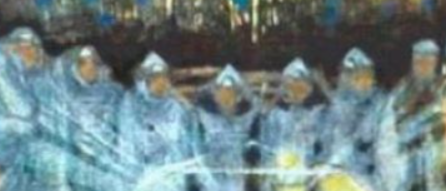
In the background, forming an arc of a pale blue color, are the seven Rishis, the great teachers from the Primal Indian Epoch. Rudolf Steiner taught that these seven men were reincarnated in the 13th century in central Europe in order to participate in this momentous event.
From a lecture given by Rudolf Steiner in 1908:
Through our various embodiments we have different experiences. We discover different relationships with each incarnation and our own relationships develop accordingly between birth and death. Now the question can arise: are the experiences between death and a new birth always the same, even though the experiences in the physical are so varied? In other words, does life in Devachan at all times during physical development always remained the same? That there is also a possible history for the life on the Other Side, will be solved through the following.
Let's remind ourselves of the state of consciousness of the old Atlanteans who still saw physical objects indistinctly, with misty outlines, in their clairvoyant condition during the day — like a lantern in fog — and during the night were comrades of the Gods; for night and day were not strictly separated as today.
The most progressive Atlanteans who had largely lost their clairvoyant awareness and already saw physical things in sharp outlines, lived in the region of today's Ireland, under the high spiritual being called Manu. They moved about in separate troops, one of these under the direction of Manu, from west to east. Then the great Flood came and after that colonies were established from Central Asia. The first was the creation of the Indian culture.
For the old Indians who still carried memories of Atlantean times, who were still comrades of the Gods, experienced everything confronting them in the earthly realm, even the starts, as illusion, Maya. Links with the spiritual world which the Indians longed for was held up by the holy Rishis. They proclaimed the existence of the spiritual worlds. There were seven Rishis; they were disciples of Manu. They could only learn during certain times when they found themselves in a particular condition. They were the entire comfort, the whole force of the then Indian world; they narrated about the wonders and laws of the spiritual worlds. When people died, they went through as the Rishis had described, but only up to a certain height of Devachan, because only the initiated, the Rishi, could experience the whole of Devachan. Yet these people were sent at that time to work in life on the Other Side.
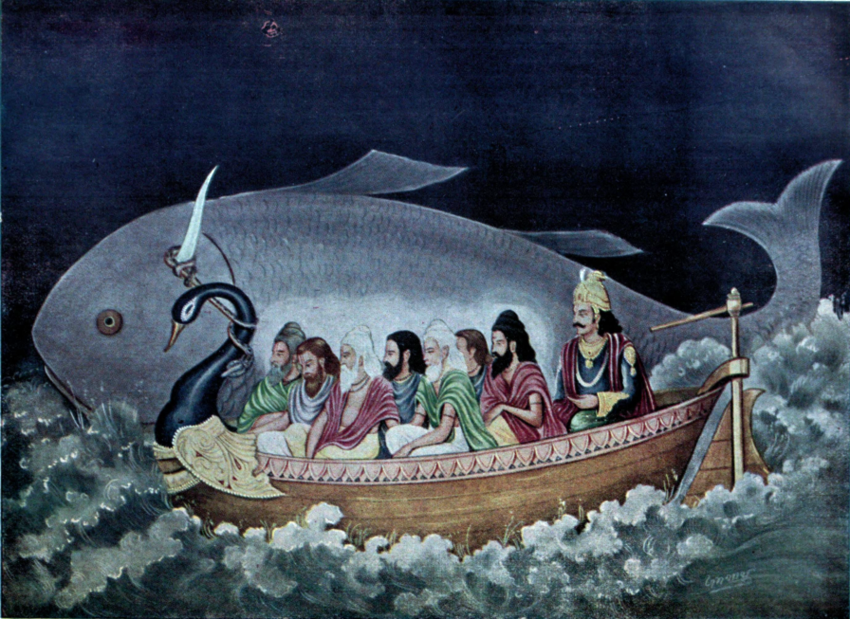
Manu and the seven Rishis at the deluge Joan of Arc

On the immediate left is Joan of Arc, identifiable here as a woman in armor holding her battle standard. On the Joan of Arc website (https://saint-joan-of-arc.com/banner.htm) I found the following information regarding what is depicted on the standard she is holding. The author of this book (A. Anderson) speculates what is on the banner is an image of Christ Jesus. He is very correct.

"I asked my Lord's messengers what I should do. And they answered me, saying, Take up the banner of your Lord. And thereupon I had a banner made." In Her Own Words, p. 26
In 1429, Joan commissioned a painter and Scotsman named Hauves Poulnoir, aka Hamish Power, to design a large standard and a smaller pennon. Additionally, Joan had a third flag made with a scene of the crucifixion. Father Jean Pasquerel designed the third banner for the clergy in the town of Blois.
As Anna May reported in the pamphlet that was provided with the version of the painting displayed in the Glass Palace, Joan of Arc is here as a representative of the Fifth Post-Atlantean Age.
It is intriguing that Joan of Arc was chosen as the representative of our current, Fifth Post-Atlantean Age. This becomes understandable when we learn that Rudolf Steiner taught that, because she was born at the end of the Holy Nights, or the Yuletide (Jan. 6, 1412), she was more able to receive spiritual guidance. With this gift, she was able to take up the task given to her from the spiritual world, in particular from Archangel Michael. Her task was to oppose the aggression of the English, who at that time were seeking to dominate France. These actions opposed the intention of higher beings, namely that the two countries should be separated from each other.
Rudolf Steiner once told an audience, during the Holy Nights of 1910, when referring to the Rosicrucians, that in the year AD 1250, the sun itself was at perigee at the winter solstice of the northern hemisphere, during the Holy Nights (when the sun was in the sign of Capricorn). This means that the sun was at its closest position to the Earth (GA 126, 31 Dec. 1910). This especially powerful celestial alignment had not happened since about 9,200 BC. He explains that, as a result of this, the Powers, or Spirits of Form, were more active in the human soul than they had been for millennia (GA 130, 29 Jan. 1911). This is the reason why the exceptional initiation process for Christian Rosencreutz occurred in that year.
Zarathustra

Standing next to Joan of Arc is Zarathustra, representative of the second Post-Atlantean Age.
Regarding the individuality of Zarathustra, Rudolf said the following in a lecture given in 1911:
If we would understand the significance of Zarathustra's teaching, we must realise that his mission was to communicate a certain conception of the universe to one particular section of humanity, while other streams had, as it were, a different mission in human culture. The personality of Zarathustra is all the more interesting to us in that he lived in a part of the world directly adjoining on its South side another land whose people transmitted an entirely different order of spirituality to mankind. I refer to the peoples of India, from whom arose the Vedic poets. The region permeated with the mighty impulse of Zarathustra lies to the North of the land from which the great teaching of Brahma went forth. Zarathustra's message to the world was fundamentally different from the Brahministic teachings of the great leaders of ancient Indian thought. These Indian teachings have come down to us in the Vedas, and in the profound philosophy of the Vedanta, of which the revelations of Buddha represent, as it were, the final splendour.
We shall understand the difference between the two thought currents — the one proceeding from Zarathustra and the other from the ancient Indian teachings — when we consider that man can reach the spiritual world along two paths of approach. There are two ways by which we may raise the inner powers of the soul above their normal level so that we may pass from the world of the senses into the super-sensible world. One way is to penetrate deeply into our own souls, to immerse ourselves, as it were, in our inner being. The other way leads behind the veils spread around us by the physical world. Both ways lead into the super-sensible world. If in the intimate experiences of soul life we so deepen our feelings, ideas, and impulses that the powers of soul grow stronger and stronger, we can descend mystically into the "Self." Passing through that part of our being which belongs to the physical world, we may indeed find our real spiritual essence — the imperishable essence that passes from incarnation to incarnation. When we pierce through the veil of the inner being with all the desires, passions and inner experiences of soul (which are only one part of us in so far as we live in a physical body) we then reach our eternal essence and enter a world of spirit. On the other hand, if we develop powers which not only perceive the physical world with its sounds, colours, sensations of warmth and cold — if we so strengthen our spiritual powers that they can penetrate behind the encircling veil of colour, sound, warmth, cold and other physical phenomena — then our strengthened spiritual forces will reach the super-sensible worlds, stretching before us into boundless distances, into infinity. The first way is that of the Mystic; the second the way of Spiritual Science. It was along one of these two ways that the great teachers attained to the revelations of truth which they had to inculcate into mankind as the basis of culture.
Zarathustra handed down to his disciples the secret of how to strengthen the powers of understanding in order to penetrate the veil of the outer world of sense. Zarathustra did not teach as did the Indian mystics: "Turn away from colours, sounds and all the outer impressions of the senses, and seek the way into the spiritual worlds entirely by means of inner contemplation, in your own soul life." On the contrary, Zarathustra taught: "Strengthen the powers of knowledge and understanding for everything that lives, be it plant or animal; understand all living things in air and water, on the mountain heights or in the valleys. Look upon this world!" We know that for the Indian mystic, this world was Maya — illusion; he turned from it in order to find Brahman; but Zarathustra taught his disciples rather to penetrate the world with understanding and to feel, behind the outer realm of physical phenomena, the reality of a spiritual power, active and creative.
Let us try to condense into simple language the doctrines which Zarathustra tried to inculcate into his disciples. He spoke thus: "Man, as we perceive him, is not merely composed of a physical body, for this physical body is but the outer manifestation of the Spirit. Just as the physical body is nothing but the manifested crystallisation of the Spiritual in man, so the Sun, in so far as it is a body of luminous matter, is nothing but the external body of a spiritual Sun." The spiritual part of man is spoken of as the "Aura" — or "Ahura," to use the old expression — in distinction to his physical body and in the same sense the spiritual part of the physical Sun may be called the "Great Aura," for it is all-embracing. Zarathustra called that which lies behind the physical Sun, Aura Mazda or Ahura Mazdao — the Great Aura. With this spiritual essence behind the Sun, all spiritual experiences and conditions are bound up, just as the existence and well-being of plants, animals and all that lives on Earth are bound up with the physical Sun. Behind the physical Sun lives the spiritual Lord and Creator, Ahura Mazdao. This is the derivation of the name "Ormuzd," Spirit of Light. While the Indians searched mystically in the inner self to find Brahma, the Eternal, shining like a luminous centre in man, Zarathustra pointed his disciples to the great periphery, showing them that the mighty Spirit of the Sun, Ahura Mazdao, the Spirit of Light, dwelt in the physical body of the Sun. Ahura Mazdao has to face his enemy — Ahriman, the Spirit of Darkness — just as man, who bears within himself the enemies of his good impulses, strives to raise his real spiritual being to perfection and has to battle against his lower passions, desires, and the delusive images of lying and falsehood.
Zarathustra, GA 60, 19 January 1911, Berlin
https://rsarchive.org/Lectures/GA060/English/Singles/19110119p01.htmlIncidentally, the ancient soul of Zarathustra (Zarathustra's Ego) incarnated as the Jesus child descendant of the Solomon line of David, bringing with him the purified Karma of this lofty soul, having experienced and overcome the challenges humanity has faced throughout its evolution.

Zarathustra and Ahura Mazdao, the Great Sun Being The Four Figures on the Far Right

Just to the right of the seven Rishis is Hermes (a bit more clear/visible in the enhanced copy of the painting), the high initiate responsible for the Great Pyramid and the associated remarkable cultural blossoming of the third Post-Atlantean Age (think of the seven Hermetic Principles). Note his square-ish head gear (as depicted in a 16th century woodcut of the title page of Zadith Ben Hamuel's De chemica Senioris..., Strassburg, 1566).

Hermes Trismegistis The pamphlet states that the fourth Post-Atlantean Age is represented here by three persons: Socrates, Plato and Augustine of Hippo. The individual dressed in what appears to be white robes is Augustine as monks in the Augustinian Order wore white robes (as depicted in the earliest known portrait of Saint Augustine from 6th Century Rome ~anthony).
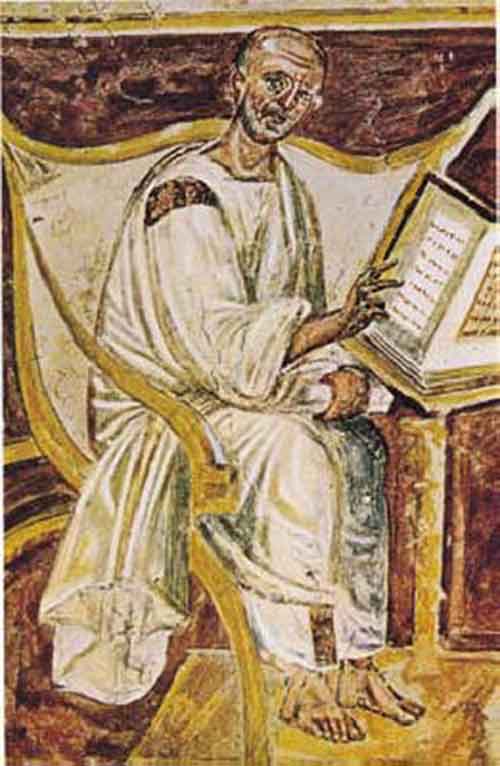
Augustine The thirteenth person, almost fully obscured behind Augustine, we can assume as being Socrates.
Socrates (470 – 399 BC) was a Greek philosopher from Athens who is credited as the founder of Western philosophy and as among the first moral philosophers of the ethical tradition of thought. An enigmatic figure, Socrates authored no texts and is known mainly through the posthumous accounts of classical writers, particularly his students Plato and Xenophon. These accounts are written as dialogues, in which Socrates and his interlocutors examine a subject in the style of question and answer; they gave rise to the Socratic dialogue literary genre. Plato's dialogues are among the most comprehensive accounts of Socrates to survive from antiquity. They demonstrate the Socratic approach to areas of philosophy including epistemology and ethics. Socrates was a polarizing figure in Athenian society. In 399 BC, he was accused of impiety and corrupting the youth. After a trial that lasted a day, he was sentenced to death. He spent his last day in prison, refusing offers to help him escape. (Wikipedia)
The statement regarding the thirteenth person in the painting being Socrates is made by the author of the book we are using here for elucidation of the painting i.e. A. Anderson. In searching through (only) a few of Rudolf Steiner's lectures, I found the following regarding Socrates as related by Plato. I feel strongly that indeed Socrates is present in the painting and his obfuscation behind Plato within itself holds meaning. I share the following from RS's leture:

Socrates In the center of the world of Plato's Dialogues stands the personality of Socrates. We need not touch on the historical aspect here. What matters is the character of Socrates as represented by Plato. Socrates is a person sanctified through death for the cause of truth. He died as only an initiate can die, one to whom death is but a moment of life like other moments. He meets death as any other occurrence of earthly existence. His behavior was such that not even in his friends were the feelings usual to such an occasion aroused. Phaedo says in the Dialogue on the Immortality of the Soul: "For my part, I had strange emotions when I was there. For I was not filled with pity as I might naturally be when present at the death of a friend; since he seemed to me to be happy, both in his bearing and his words, he was meeting death so fearlessly and nobly. And so I thought that even in going to the abode of the dead he was not going without the protection of the gods, and that when he arrived there it would be well with him, if it ever was well with anyone. And for this reason I was not at all filled with pity, as might seem natural when I was present at a scene of mourning; nor on the other hand did I feel pleasure, as was our custom when we were occupied with philosophy—although our talk was of philosophy—but a very strange feeling came over me, an unaccustomed mixture of pleasure and of pain together, when I thought that Socrates was presently to die." And the dying Socrates instructs his pupils about immortality. His personality, knowing by experience the valuelessness of life, here acts as proof of a quality very different from all logic and intellectual reasoning. It is not as though a man were conversing—for this man is at the point of crossing the threshold of death—but as though the eternal truth itself which had made its abode in a transitory personality, were speaking. Where the temporal dissolves into nothingness we seem to find the air in which the eternal can resound.
We hear no proofs of immortality in the logical sense. The whole dialogue is directed toward leading the friends to the point where they can behold the eternal. Then they will need no proofs. Is one to prove that the rose is red to someone who sees it? Is one to prove that the spirit is eternal to someone whose eyes have been opened so that he can see this spirit? Socrates indicates living experiences. First of all it is a meeting with wisdom itself. What is the aim of the person who pursues wisdom? He wishes to free himself from all that his senses offer him in everyday observation. He wishes to seek the spirit in the material world. Is not this a fact which can be compared to dying? "Other people"—this is Socrates' opinion—"are likely not to be aware that those who pursue philosophy aright study nothing but dying and being dead. Now if this is true, it would be absurd to be eager for nothing but this all their lives, and then to be reluctant when that came for which they had been eagerly practicing all along." To reinforce this, Socrates asks one of his friends, "Do you think a philosopher would be likely to care much about the so-called pleasures, such as eating or drinking? ... Or about the pleasures of sexual desire? ... Do you believe such a man would think much of the other cares of the body—I mean such as the possession of fine clothes and shoes and the other personal adornments? Do you think he would care about them or despise them, except so far as it is necessary to have them? ... Altogether, then, you think that such a man would not devote himself to the body, but would, so far as he was able, turn away from the body and concern himself with the soul? ... To begin with, then, it is clear that in such matters the philosopher, more than other men, separates the soul from association with the body"
After this Socrates is entitled to say: Striving for wisdom is comparable to dying, in that man turns from physical things. But where does he turn? He turns to the spiritual. However, can he expect the same of the spirit as of his senses? Socrates explains himself on this: "Now, how about the acquisition of intelligent insight? Is the body a hindrance or not, if it is made to share in the search for wisdom? What I mean is this: Have the sight and hearing of men any truth in them, or is it true, as the poets are always telling us, that we neither hear nor see accurately? ... Then, when does the soul attain to truth? For when it tries to consider anything in company with the body, it is evidently deceived by it." All that we perceive with34 the physical senses comes into existence and dies away. And this coming into existence and dying away is the cause of our being deceived. But if we examine objects more thoroughly with intelligent insight, then we partake of the eternal in them. But the physical senses do not convey to us the eternal in its true form. They deceive us when we rely implicitly upon them. They cease to deceive us if we confront them with logical insight, making everything conveyed by the senses subject to examination by this insight. But if logical insight is to judge the statements of the senses, must not something live within this insight which transcends the perceptions of the senses? Hence what is true and false in objects is judged by something in us which opposes the material body, and therefore is not subject to its laws. Above all, this something must not be subjected to the laws of growth and decay, for it bears truth within itself. Truth cannot have a yesterday and a tomorrow; it cannot be this on one occasion and that on another, as material things are. Hence truth in itself must be eternal. As the philosopher turns away from the transitory material world, and turns to truth, he approaches an eternal element, dwelling within him. If we immerse ourselves wholly in the spirit, then we live entirely in truth.
Christianity as Mystical Fact, chapter 3, Plato as a Mystic, GA 8, 1961 edition
https://rsarchive.org/Books/GA008/English/RPC1961/GA008_c04.htmlLastly, then, on the far right, is Plato (who was a student of Socrates). He holds in his hands the Greek 'Kerykeion' staff. This is the staff which was held by any highly notable Athenian, someone who was regarded as a worthy cultural ambassador for the Athenian state. The fourth Post-Atlantean Age is called the Greco-Latin Age, for which Plato is a very appropriate representative of the Greek civilization, while Augustine is a leading figure of the Latin culture i.e. of Roman Christianity. Socrates could also be construed as representing the Greco-Latin Age, and his appearance here remains a mystery.
Rudolf Steiner had this to say regarding Plato:

Plato In Plato there was still something alive of the ancient wisdom of humanity; that wisdom which takes us across to the ancient Orient where, indeed, in ancient times a primal wisdom had lived — but which had then fallen more and more into decadence. In Plato, if we are able to understand him properly, we find the last offshoots, if I can so call them, of this primal oriental wisdom. And then, like a rapidly developing metamorphosis, Aristotelianism sets in which, fundamentally, presents a completely different constitution of soul from the Platonic one.
The New Spirituality and the Christ Experience of the Twentieth Century, GA 200, 17 October 1920, Dornach
https://rsarchive.org/Lectures/GA200/English/RSP1988/19201017p01.html- XIV. St. Paul on the Road to Damascus ( D7 )

We now come to the holiest reality to which Anthroposophy can provide insights into. This is the relationship of the human soul to Christ, and this includes the theme which Rudolf Steiner refers to as "the Reappearing of Christ". This part of the painting is directly below the scene depicting the inititiation of the youth in AD 1250. Here we see St. Paul at that moment on his journey to Damascus, when Christ Jesus makes himself visible to him. A meditative engagement with this part of the painting leads on to the theme of how does a human being encounter Christ, and this leads to some profoundly sacred words of Rudolf Steiner about this topic. The reason for the fact that St. Paul is not depicted as gazing at the risen Jesus is significant. Instead we see something else. We see the flaming menorah-bush of the first part of the painting, now metamorphosed into seven roses on a bush. So we realize that the scene involving St. Paul needs to be contemplated together with the mirror-image of the St. Paul scene in the opposite side of the painting: The experience of Moses before the burning bush.
- XV. The Risen Christ ( D8, D9, D10 )

The Seven Flames of the Menorah Transformed
In the first panel of the painting we saw three people standing in front of the Holy of Holies in Solomon's Temple; and below this, the seven-branched menorah indicating the cosmic origin of the human being, sustained by Jahve-Christ, which exists hidden in the soul. In this third panel we see the counterpart to this in a sacred mystery. Depicted is Saul on the road to Damascus suddenly beholding the Saviour, in the etheric. However here we are not shown the risen Christ Jesus but instead a holy mystery. The seven flames of the menorah in front of Moses have become seven roses; the central rose is encircled by a crown of thorns, from which rays of spiritual light stream forth. This 'bush' of seven roses alludes to the rose-cross symbol, created by Lazarus-John in his medieval incarnation as Christian Rosencreutz.
Whereas St. Paul beheld the etheric risen Jesus, in the painting we are shown the transformation of the seven-fold menorah-bush of Moses into a bush of seven roses. We are beholding the sevenfold soul-forces now sanctified; the seven roses represent the seven chakras which 'blossom' when the astral body has become enobled, bringing into birth the higher Self. But since this image here is in effect a replacemetn for the Risen Saviour, we are also being told two things:
- In a certain sense the radiant sevenfold higher Self is the Christ Himself
- This higher Self has its origin in the spiritual light from Christ, derived from the light of the Cosmic Christ permeating the Earth
It is also being conveyed that our spiritualization is a process made possible by the sacrifice of Christ Jesus, signified by the crown of thorns placed around the heart chakra (being the central chakra):

Incidentlally, I find it interesting that the position of the crown (the fourth position) also corresponds to the fourth cultural Epoch of the Fifth Post-Atlantean Age, the Greco-Latin Age, the Age wherein the Christ incarnated in Jesus of Nazareth and was crucified. ~anthony

To really understand this section of the painting, we must be reminded that it is a core truth in Anthroposophy that at the Baptism of Jesus in the Jordan, Jesus became united to the Cosmic Christ, becoming Christ Jesus. This sublime process was fully consolidated at the Resurrection, which occurred on April 5th, AD 33. Through this, Jesus (the human side of the individuality that was Christ Jesus) became the crucially important archetype of the spiritually re-born human being*: The human being who has achieved their eternal higher ego. For once such an archetype has been created, then all human beings, who so will, can become spiritually re-born in the course of time (i.e. over 'n' incarnations).
Once the Baptism took place, there occurred the union of the soul and spirit of Jesus (whose birth is recorded in St. Luke's Gospel, and whose ancestor was Nathan the priest✝), to the Cosmic Christ: A situation which became an eternal reality as from the Resurrection. From that day on (April 5, AD 33), the Nathan-Jesus soul, as such, disappears from the world because He became Christ Jesus. That is, He is a divine person, in whose Self or "I" is the Cosmic Christ; for, as Rudolf Steiner taught, Jesus [the] Christ is the archetype of the future, fully perfected human being, a human being with the Spirit-self, Life-spirit and the Spirit-human. We know from Rudolf Steiner's lectures on the Gospels, that this person is the unique, and uniquely divine, unfallen soul wo has his first, and only, incarnation in Palestine, and Who then became the vessel of the Cosmic Christ. Rudolf Steiner taught that this divine soul has "all the love [capacity] that a human being can ever attain."
* To understand this in greater depth, I recommend the book by Emil Bock, The Three Years. In short, during the three years of Jesus' 'ministry' He was in a continual state of incarnating, that is, the Christ was continually incarnating in human flesh. When a ('regular') human being incarnates, there is a time of intitial development whereby the child is not fully incarnated i.e. fully separated from his spiritual self. This would account for those children that 'remember' a former incarnation, which slowly fades over time. Jesus' three year 'ministry' mirrors that process, as He incarnated in an adult human being, Jesus of Nazareth. This also sheds light on Jesus' prayer in the Garden prior to His arrest i.e He had become at that point fully incarnated into the human body of Jesus of Nazareth. ~anthony
✝ For more on the topic of the "Nathan-Jesus" etc., I refer you to Rudolf Steiner's Fifth Gospel and the book by Emil Bock, The Childhood of Jesus.
The Masonic Zodiac

From the zodiac symbols beneath the sevenfold menorah bush near Moses in the first 'panel', which represent the matrix of the human soul and ego-sense (the seven planets within the astral body and the twelve-fold zodiac influence, which underlies our body and our senses and part of our higher ego). Here in the last panel, where the seven flames have become seven roses, so too have the astral influences of the zodiac blossomed into noble qualities, the zodiacal influences becoming more conscious, more refined through repeated earth lives. The zodiac symbols have here been exchanged for symbols which speak of specific soul qualities. Unfortunately, very few of the symbols are clear in what has been preserved in the painting.
I (Anthony) don't particularly agree with what the author (A. Anderson) posits regarding what each of these 'transformed' symbols represent, at least as far as any clarity of the image could be made. Instead, through some digging, I found the following, which I ascertain (might) be closer to what is intended by what we are referring to here as 'masonic zodiac' symbols. In a lecture given on the 6th of June, 1906, titled The Astral World in a lecture series covering 'An Esoteric Cosmology', Rudolf Steiner shared the following. I included the portions immediately around the paragraph that is important here, which itself is highlighted.
The occultist will never dream of imposing dogmas. He is one who tells what he has seen and tested in the astral and spiritual worlds or what has been revealed to him by trustworthy and reliable teachers. He does not desire to convert but to quicken in others the sense that has awakened in him and to enable them to see likewise.
Here we shall consider man as an astral being as he is revealed by clairvoyant vision. The astral being of man includes the whole world of feelings, passions, emotions and impulses of the soul. To inner sight these are changed into forms and colours. The astral body itself is a cloud-like, ovoid form, permeating and enveloping man. We can perceive it from within.
In man as a physical being, we have to consider the substance and form of the body. The astral substance entirely changes in the course of seven years, but the form remains. Behind substance is the constructive, upbuilding principle — the etheric body. We do not, in the ordinary way, perceive it; we only see its accomplished work, in the physical body. The eye of sense only sees what is finished, not what is in the state of becoming.
The contrary is the case when we are able to see the astral body — that is to say, our own astral body. We become aware of it from within through our desires and the various movements of the soul.
Seership consists in learning to see from without that which in ordinary life we feel from within. Feelings, desires and thoughts then become living and visible forms, constituting the aura around the physical sheath.
The etheric body builds and moulds the physical body; the astral body is made up of desires. Every human aura has its own individual shades and predominating colours. There is one fundamental colour in which the others play. The aura of a man with a melancholic temperament, for example, is of a bluish hue. But so many impressions coming from without flow through it that the observer may easily be deceived, above all if he is looking at his own aura. The clairvoyant sees his own aura reversed, as it were, the outer as the inner, the inner as the outer, because he is observing it from outside.
All the great Founders of religions have been possessed of clairvoyant sight. They are the spiritual Guides of mankind, and their precepts are precepts of the moral life based on astral and spiritual truths. This explains the similarities in all the religions. There is a certain similarity, for instance, between the Eight-fold Path of the Buddha and the Eight Beatitudes of Christ. The same underlying truth is that whenever man develops one of the virtues, he unfolds a new faculty of perception. Why are eight stages mentioned? Because the seer knows that the faculties which may be transmuted into organs of perception are eight in number.
The astral organs of perception are called in occultism, the 'lotus-flowers' (sacred wheels, chakra). The lotus-flower with sixteen petals lies in the region of the larynx. In very ancient times this lotus-flower turned from right to left — that is to say in the opposite direction to the hands of a clock. In the man of today, this lotus-flower has ceased to turn. In the clairvoyant seer it begins to move in the opposite direction — from left to right. In earlier times, eight of the sixteen petals were visible, the others undeveloped. In future ages they will all be visible, for the first eight are the result of the action of unconscious initiation, the other eight of the conscious initiation attained by dint of personal effort. The eight new petals correspond to the Beatitudes of Christ.
Another lotus-flower (with twelve petals) is situated in the region of the heart. In earlier times, six petals only were visible. The acquisition of six virtues will, in times to come, develop the other six. These six virtues are: control of thought, power of initiative, balance of the faculties, optimism which enables a man always to see the positive side of things, freedom from prejudice, and finally, harmony in the life of soul. When these virtues have been acquired, the twelve petals begin to move. They express the sacred quality of the number twelve which we have in the twelve Apostles, the twelve knights of King Arthur, and again in all creation, in all action. Everything in the world develops according to twelve different aspects. We have another example in Goethe's poem, Die Geheimnisse, which expresses the ideal of the Rosicrucians. According to the explanation given by Goethe to certain students, each of the twelve Companions of the Rose Cross represents a religious creed.
Therefore, as I see it, the symbols represent the development of the six higher virtues from the six presently acquired virtues in that of a seeker i.e. occultist i.e. Anthroposophist. Trying to identify what is actually being depicted here in the painting, then assigning meaning to that 'guess' seems far to arbitrary and abstract, in my (humble) opinion. I'm simply using this portion of the painting to share what I found that may or may not apply simply as teaching tool. ~anthony
We find these virtues expressed again in signs and symbols, for symbols are not arbitrary inventions — they are realities. The symbol of the Cross, for instance, as well as that of the Swastika*, represents the four-petalled chakram in man. The twelve-petalled flower is expressed in the symbol of the Rose Cross and the twelve Companions. The thirteenth among them, the invisible Companion who unites them all, represents the truth that unites all religions.
This truth underlies the rites and ceremonies of the various religions. Divine wisdom speaks through the rites and cults which have been founded by seers. The astral world expresses itself through them in the physical world. As in a reflection, the rite represents what is happening in higher worlds. This fact appears again in masonic ritual and in certain Asiatic religions. At the birth of a new religion, an Initiate gives the foundations upon which the ritual of the outer cult is built. As evolution proceeds, the rite — a living picture of the spiritual world — tends towards the domain of Art. Art, too, comes from the astral world; the rite becomes beauty. This came to pass notably at the time of Greek civilisation. Art is an astral event of which the cause has been forgotten.
We have an example in the Mysteries and Gods of Greece. In the Mysteries, the hierophant retraced the development of man in its three stages: man the animal, man the human, man the God (the true Superman, not the false Superman of Nietzsche). The hierophant projected these three super-sensible types as living images into the astral light, where they were visible to those who had been initiated into the Mysteries. At the same time they were expressed in poetry and sculpture by three symbols: (1) the Satyr, or bestial type; (2) the human type: Hermes, or Mercury; (3) the divine type: Zeus, or Jupiter. Each of these figures, together with everything around them, represents a cycle of human evolution. That is the way in which the disciples of the Mysteries carried over into Art what they had seen in the astral light.
* Though this is quite a 'rabbit-trail' offshoot of the intent of this (webpage), I felt sure the mention of the swastika would raise an eybrow, so I did some followup to this statement made by Rudolf Steiner. The symbol of the swastika is ancient and can be found in ancient writings, monoliths, etc. the world over. In a lecture given in 1923 only months before his death, Rudolf Steiner talks about having seen the swastika on ancient Druidic stone monoliths in Britain (https://rsarchive.org/Lectures/GA350/English/RSP2000/19230910p02.html).
In a lecture given in 1920, he said the following regarding the swastika:
I have called your attention to what happened, for example, in the East, in Asia. Once upon a time, so I told you, conditions in Asia were of a kind that the human being felt his heart expand, felt his soul grow warm, when, guided by the thought of the sacred Brahman, he directed his glance to the mighty external symbol of the swastika, the hooked cross. It made his inner life unfold. This inner mood of soul meant a great deal to him. Today, when an Oriental receives an ordinary Russian 2,000 ruble note — which is not worth much, for small change will no longer do for buying anything, only thousand ruble notes — he sees on it the beautifully printed swastika. Those thousand-year-old feelings that once upon a time inwardly beheld the sacred Brahman when the eye was directed to the swastika are certainly stirring. Today, the same emotional qualities arise on seeing the 2,000 ruble note.
And, since I am already on this rabbit-trail, he followed that statement with the following, in regard to such a sacred symbol appearing in such an Ahrimanic setting i.e. paper money.
Do you believe that one has a spiritual view of the world if one does not look at something like that and say to oneself, "Those are the Ahrimanic powers who are at work here; herein lies a super-earthly intelligence, even though it is an Ahrimanic intelligence?" Do you believe that it suffices merely to say, "Oh, that is the external material world! We direct our glance heavenward to spiritual things; we don't pay any attention to things for which people only have words?" If you seek for the spirit, you must look for it even where it turns up in the mighty aberrations of external world evolution itself, for there you can find the starting point for other aspects.
It is the tragedy of modern civilization that people believe that only human forces are at work everywhere, forces which arise between birth and death. Actually, our world is permeated all over by super-sensible forces, spiritual powers which manifest themselves in the various events that take place. If one wishes to do something, if one tries to realize intentions so that this or that result may come about, one needs to look to those benign spiritual powers capable of workiSng against other spiritual powers; and the spiritual powers that can oppose the others have to be born in man through his own inner activity.
We must come to terms with our perceptions and strive to not only gain, but truly understand a wider (and deeper) view of the world around us. Incidentally, regarding the swastika showing up on printed money, I found the following short article by one Eric Mueller 'printed' on the Action Report website of The International Campaign for Real History. Included below are two images of the Russian banknotes mentioned in the article.
I OWN THREE Russian banknotes that were issued in 1917 by the Provisional Government in Russia. That is, after the overthrow of the Tsar, but before the Bolsheviks took over. Hence the design of a double eagle that has been stripped of its crown and scepter. The hammers and sickle did not make its appearance until the Bolsheviks, of course.
The notes are of interest in terms of the history of the Nazi swastika and in terms of the absurd notion that the swastika has something to do with hostility to Jews.
First, it's a bit hard to see, but if you look closely at the double eagle on the 250 Ruble note and at the center of the 1000 Ruble note, you'll see that they both feature swastikas in the background.
Not only swastikas, but swastikas rotated to the 45-degree angle later favored by the Nazis. The proportion and thickness looks about the same as the Nazi style swastikas as well.
In 1917 Adolf Hitler was still in some trench on the western front. These notes make me wonder if someone with Russian connections might have had a hand in designing the Nazi emblem -- Alfred Rosenberg, maybe?
Second, with regard to the identification of swastikas with hostility to Jews, the Russian provisional government that issued these swastika notes was anything but anti-Semitic. Well-known Jews like Jacob Schiff in the US provided cash to the Provisional government, which removed all the restrictions that the Tsarist government had imposed on Jews in Russia.
These swastika banknotes were issued by a government which Jews around the world hailed as their liberator.
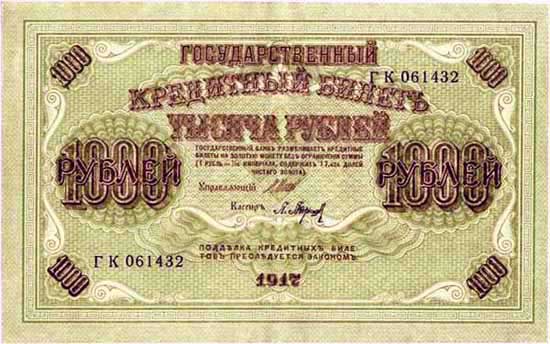
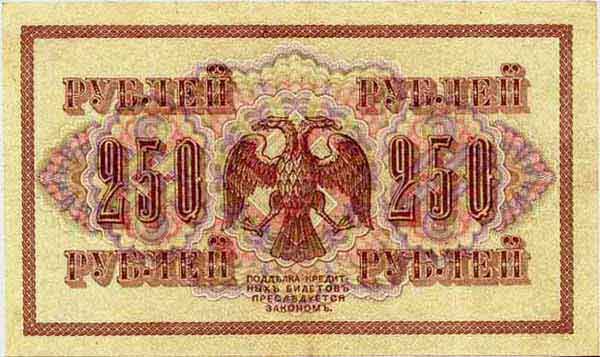
I made some adjustments to the top image and enlarged the center to make it a bit easier to see the swastika in the background:
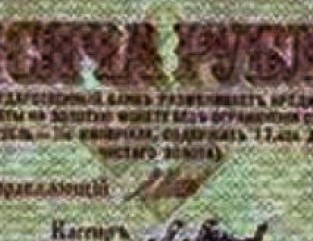
- XVI. The Sophia (Spirit-self) Figure of the Apocalypse ( B11 )
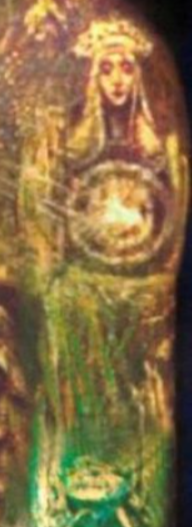
Prominently placed at the far right side of the overall painting is an image which is closely linked to a passage in the Book of Revelation (12:1):
A great and wondrous sign appeared in heaven: A woman clothed with the sun, with the moon under her feet and a crown of twelve stars on her head.
The painting begins at the far left side in Atlantean times with Melchisedek, leader of the Sun oracle in Atlantis, and finishes with this figure at the far right. This feminine figure speaks about the final outcome of the millennia of activity of the intitiates who serve the Christ Impulse: The Spiritual-self arising within spiritualized humanity. The spiritual-sun, the source of the Spiritual-self, is now within the human being. In accordance with the apocalyptic vision, the moon is shown here (though blurry) beneath the figure.
The image is a depiction of a Sophia person, that is, a human being who has developed their Spiritual-self; it is not a goddess. A lack of clarity about this theme easily brings about incorrect ideas based on old religious views, as a study of Anthroposophy reveals. For example, Rudolf Steiner taught in regard to this theme that, "Mary, who gave birth to Jesus, had developed the Spirit-self, and for this reason she was called 'Sophia' by the early Christians." (GA 97) So there was no goddess reposing in the aura of the Virgin Mary but rather 'Sophia' means that she had acquired the stage of Spirit-self.
In various lectures, Rudolf Steiner explains why earlier initiates amongst the Greeks, chose the feminine term 'Sophia', and why the initiates amongst the Egyptians chose the feminine term 'Isis'. The reason is that such initiates were aware of how cosmic energies streamed into the pure, newly formed Spirit-self; this is a receptive, feminine dynamic. We learn about this, for example, in a lecture entitled "Isis and Madonna" where Rudolf Steiner refers to paintings of Mary the mother of Jesus, such as the Sistine Madonna. Of this painting he comments, "Thus we have before us in the Sistine Madonna a picture of the human soul as born out of the spiritual universe."
He explains that these images portray qualities in the higher soul or Spiritual-self, which are similar to those behind the ancient Egypitian Imagination of Isis. He then comments on the receptive quality of Isis or the Spiritual-self (or Sophia), "This Isis, when she has purified and cleansed everything which she has received from the physical world, becomes fertilized from out of the spiritual world and then gives birth to the higher human being." (GA 57)
This same teaching about the receptive or feminine quality of our 'Sophia' or Spirit-self, with regard to in-streaming cosmic spiritual forces, is presented in other lectures. For example, in 1907, when Rudolf Steiner was speaking about the famous passage in Goethe's Faust, "THe Eternal-feminine leads us onwards", he indicates that htis viewpoint is similar to the spiritual wisdom behind the term 'Isis'. He comments that, "The soul is that which is permeated by cosmic dynamics, and it is these cosmic dynamics that she is united, as if in a marriage."
It is clear here that the term, 'the soul', means the astral body which has been enobled and spiritualized, and is on its way toward the Spiritual-self. So we learn from thse words that our Spiritual-self is receptive to, and therefore permeated by, spiritual forces in a feminine, receptive sense. In other words, with the clairvoyance of the Spiritual-self state, the acolyte felt his or her soul receiving the in-raying energies of the cosmos, and this kind of receiving is a feminine dynamic. The main occasion where Rudolf Steiner's words appear to refer to a goddess occurs in his famous lectures, The Search for the Isis-Sophia, which refer to the ancient Egyptian perspective. In this context, Rudolf Steiner explains that in Egypt, Isis was depicted at times as a personification of the cosmos, no alive to clairvoyant vision with its many divine beings, nature spirits and general astral-etheric forces,
Isis is the personified All-wisdom of our world...in her true figure, Isis is permeating the entire cosmos...she is that which shines radiantly towards us in many auric colors from the cosmos... (GA 202, Dec. 24th, 1910)
In regard to 'anthroposphia', Rudolf Steiner told his audience in 1913 of the need to become aware of this spiritually uplifting result of seeking wisdom, of letting wisdom (in Greek, Sophia) really be present in the human soul (in Greek, anthropos). In this way a new personification of the soul-quality of the wise person, and also of the beautifully enlivened cosmos, can arise; it is this which the word 'Anthroposophia' expresses. He wanted the audience to really feel a more mature version of the poetic-romantic 'Sophia-Beatrice' idea in regard to the Spiritual-self. He explained that students of anthroposophical wisdom should feel, through the spiritualizing of their consciousness, as if a divine reality envelops their soul when anthroposophical wisdom permeates it. As he explained on another occasion,
...anthroposophy is nothing other than that 'Sophia', tht is, that consciousness-content or inwardly experienced element of the human soul, which makes a human being full a human being...it gives 'Sophia', that is, a certain kind of consciousness to the soul. (GA 257 in 1923)
Here, at the end of the painting, the future human being si depicted, in whom the Spirit-self has developed, and this the 'Sophia' consciousness arises, to use the language of medieval and Greek mystics. This shall occur in some future time-cycle, as Rudolf Steiner indicated when he commented on the fifth of the 'Apocalyptic Seals',
The cosmos will have changed greatly by then; in the human being, the Sun power will be prsent. The power of the sun in the human being will bring forth a sun. (GA 285/5, 1907)
Not long ago I ran across this sketch by a David Dozier of the Anthoposophia. I added a bit of tint to emphasize all of the symbolism. ~anthony
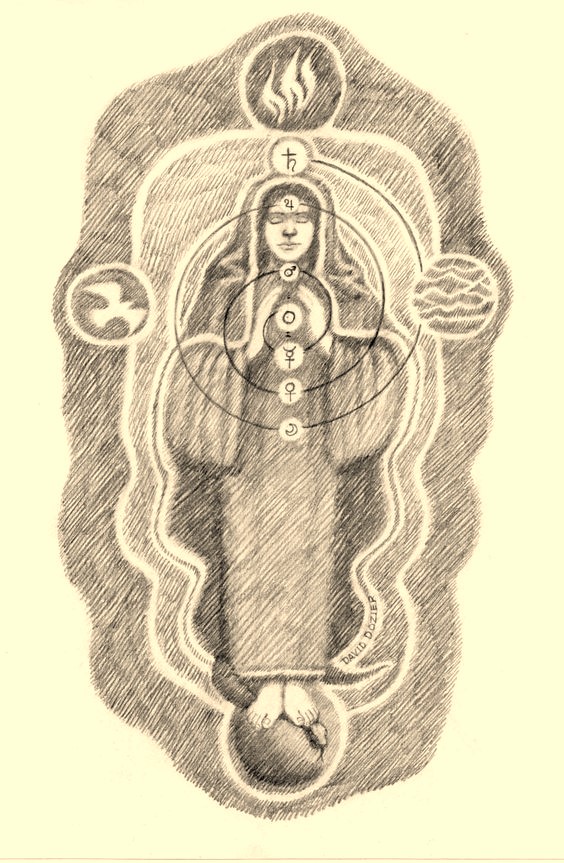
- XVII. The Archangel Michael Conquering the Dragon ( C11, D11 )

Underneath the Sophia is a depiction of the Archangel Michael, who is holding the Dragon in chains (the dragon portion too obscure to be seen clearly). This is the third occasion in which Michael is depicted in the painting. In the modern era, this Archangel strives to help those who seek to develop a sincere spirituality, to overcome the materialistic attitudes which in recent centuries have plagued humanity; and to even advance through to attaining spiritual cognition i.e. a clairvoyant higher consciousness. All of anthroposophical wisdom can be viewed as a presentation of what Michael taught, in what Rudolf Steiner described as the spiritual School of Michael.
By this term he means that in the spiritual worlds, some centuries before the twentieth century, Michael gathered millions of human souls and various spiritual beings around him, and taught them what we know now as Anthroposophy. This was done for the purpose of helping those souls, when they began to incarnate in the modern era, to have an inherent feeling for these spiritual truths, and to thereby weaken the power of Ahriman, whose influence is predestined to become very powerful in our times.
Rudolf Steiner explains that Michael, in modern times, is battling for the integrity of what Rudolf Steiner refers to as 'cosmic intelligence', as reflected in us humans. By this term he means the spiritual consciousness or the wisdom of divine beings, but as reflected in our thinking life, in how we human beings think. Michael seeks to help human beings to think spiritually, and here thinking does not only mean logical intellectual activity; it also means intuitive, holistic higher consciousness, which then leads on to spiritual-clairvoyant consciousness states.
Hence Rudolf Steiner describes this great Power as 'the Guardian of cosmic intelligence'. Consequently his concern now is, to strive to help the light of wisdom from the divine worlds, or 'spiritual thinking', to live on in our human soul; even though as incarnate people, we are so subject to 'brain-bound' earthly thinking. Consequently, spiritual striving today is helped by Michael in a very substantial way.
I want to end this page with the following artwork of David Newbatt of the Archangel Michael, depicted here as the Archangel of the Autumn season (Michaelmas), and what has been given to us from Rudolf Steiner referred to as the "Michael Prayer". Rudolf Steiner taught that the way in which the name Michael, in reference to the Archangel, is very poorly pronounced. There is a lack of emphasis on the last portion of the name i.e. "El", which is a reference to the Godhead. Therefore, the more accurate way in which to pronounce (even in thought) the name of the Archangel Michael is "My - kai - El", assuring emphasis on "El". ~anthony
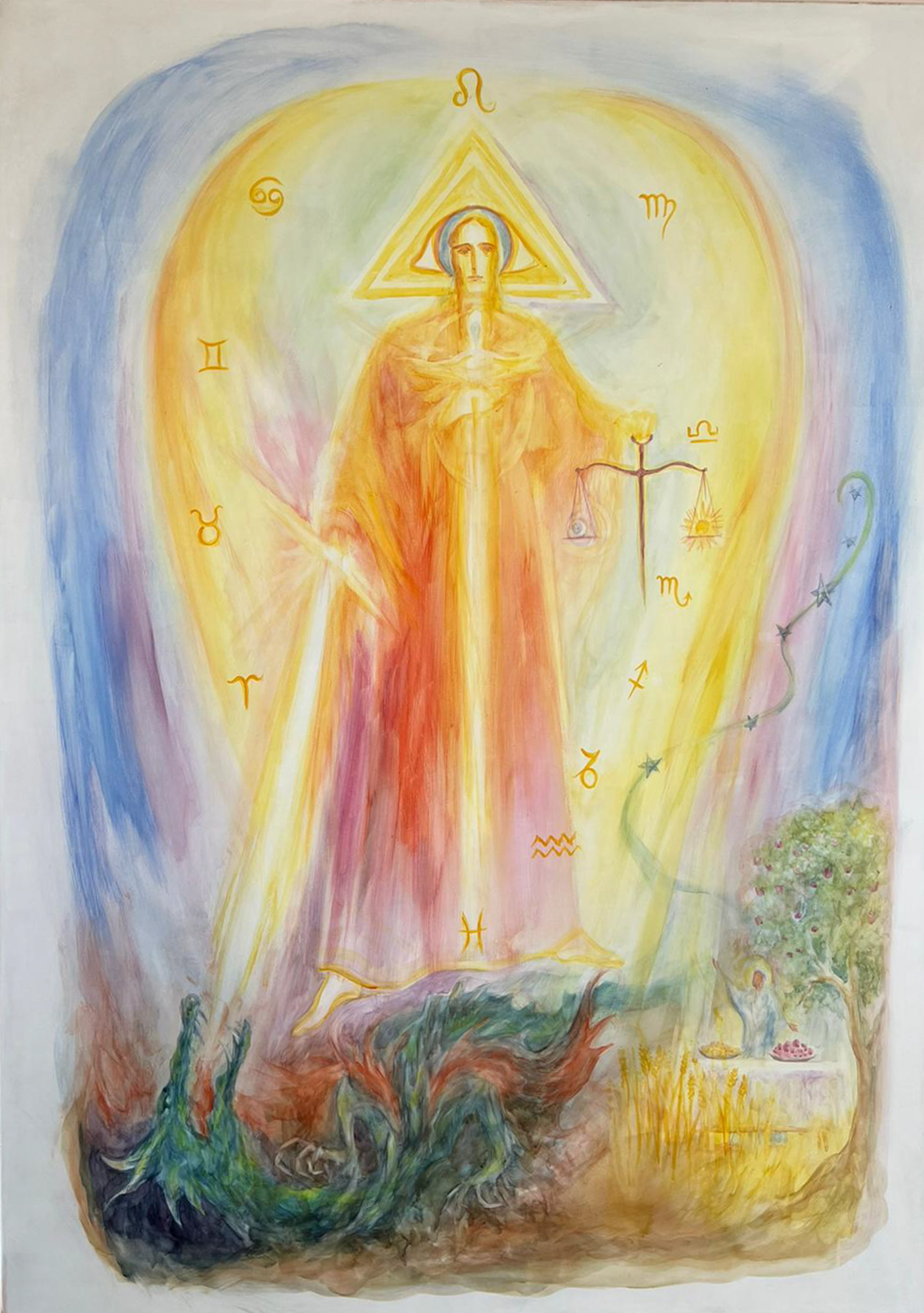
Michael!
Lend me thy sword
That I may be armed
to vanquish the dragon in me.Fill me with thy strength
That I may bring into confusion
The spirits who wish to paralyze me.Work in me
So that the light irradiates
My I, and that I may be led
To deeds worthy of thee.Michael!
